






















































































BY SUZETTE SMITH
This is not a time to fight with one another. This is a time to get along. You don’t have to make nice with people who refute your very existence, but I do need you to walk behind the person in your building who trods at the pace of a locked shopping cart and just BE COOL.
This spring you are called to make alliances with those around you: team up on a idea, do fun
For the Spring Arts Trash Report, we asked Elinor Jones to write up some arts news and she instead pointed out that, after writing B00BS on ourcalculators for most of our youths, AI will soon be able to write B00BS on us—I for one welcome it. Also the Goonies might be getting back together!
In a glimmer on the horizon, a local music promoter is challenging Live Nation's land use permit.
City councilor Jamie Dunphy has some ideas for how to make Portland more friendly to local musicians and music venues.
A founder of brand new nail art show ManiFest, Asa Bree says she hopes it can be fun for everyone— from nail art admirers to nail DIYers to fine art lovers.
stuff with your friends, lock eyes on the dance floor—platonically or otherwise. However, we are not asking that you do this purely from invention. Artists, performers, and local politicos are setting the pace with new projects, plans, and perspectives to inspire you to collab—collab with all your might!
Here are just a few of the amazing alliances you’ll find in the Mercury’s 2025 Spring Arts Guide:
The collaborators behind Monet’s Floating Worlds at Giverny at Portland Art Museum have so many titles, we dedicated an entire paragraph to them.
In our seasonal art show round-up, at least one gallery wants you to come to lunch.
Multimedia artist Patricia Vázquez Gómez says that making a poster for an organization is not beneath her talents, because "images that make people imagine and dream of better things play an important role."
Stumptown Stages' production of comedy musical Tootsie is co-directed by its co-stars!
Speaking of theater, Sapience is sort of about a friendship between a teenage boy and an orangutan, but our eyes were on the tortured scientist love triangle.
27 29 30 33 39
Emma Pattee's debut novel Tilt begins at the Portland IKEA; we met her there for an interview and she showed us how to get free coffee.
In her new collection Stag Dance, author Torrey Peters dreams of a dystopia where trans women support one another— “All it took was the end of the world to make that happen,” a trans homesteader in the book observes.
At the Mercury Geniuses of Comedy, ten comics collaborate with us to make you laugh!
The collabs don't stop in EverOut’s spring calendar—Lidia Yuknavitch interviews Rebecca Solnit, Silkroad Ensemble continues an idea created by Yo-Yo Ma, and you're invited to a costume parade to celebrate Making Earth Cool.
Even Savage Love kept with the party theme; get on Team Fantasize! 5 7 9 11 13 15 16 19 20 22 25
FISK design agency founder Bijan Berahimi curated his 100+ artist show, Eyes and Ears, to connect creatives locally and in larger design scenes.
EDITOR-IN-CHIEF
Wm. Steven Humphrey
NEWS EDITOR
Courtney Vaughn
ARTS & CULTURE EDITOR
Suzette Smith
MUSIC EDITOR
Nolan Parker
NEWS REPORTER
Taylor Griggs
MANAGING EDITOR
Janey Wong
FOOD & DRINK EDITOR
Julianne Bell
MUSIC CALENDAR EDITOR
Audrey Vann
ARTS CALENDAR EDITOR
Lindsay Costello
DATA MANAGER
Shannon Lubetich
Business
COMPTROLLER
Katie Lake
Best-friend bookstores Literary Arts and Mother Foucault’s now live across the street!
ADVERTISING DIRECTOR
James Deeley
ADVERTISING COORDINATOR
Evanne Hall
SENIOR ACCOUNT EXECUTIVES
Anna Nelson
Katie Peifer
ART DIRECTOR
Corianton Hale
ASSOCIATE ART DIRECTOR
Anthony Keo
PRODUCTION MANAGER
Char Harris
PRODUCTION
David Caplan, Feedback Graphics
MARKETING DIRECTOR
Caroline Dodge
SOCIAL MEDIA MANAGER
Christian Parroco
EMAIL MARKETING SPECIALIST
Tonya Ray
PRODUCTION DIRECTOR
VIDEO
Shane Wahlund
HEAD OF PRODUCT
Anthony Hecht
SENIOR DEVELOPER
Nick Nelson
SENIOR DEVELOPER
Michael Crowl
IT MANAGER
Grant Lewicki-Hendrix
CUSTOMER SOLUTIONS MANAGER
Kevin Shurtluff
CLIENT SOLUTIONS MANAGER
Diana Schwartz
PROJECT MANAGEMENT
CLIENT & CUSTOMER SOLUTIONS REPRESENTATIVE
Campy Draper
CUSTOMER SOLUTIONS REPRESENTATIVES
Katya Schexnaydre
Anita Chao
distribution@portlandmercury.com
COO/CFO
Rob Crocker
CHIEF OF STAFF
Toby Crittenden
CHAIRMAN AND PUBLISHER
Brady Walkinshaw






























BY ELINOR JONES TRASH, BUT MAKE IT SPRING ARTS!
Hello, and welcome to a very special Trash Report. I usually write this newsy gossip column for the internet, but the top brass at Mercury HQ let me out of the computer to write–in print–because, what is a free alt-monthly if not a report, that eventually becomes, how you say, trash? (Or recycling, obviously, but you know what I mean.) I’m qualified to write about art because as a writer, I technically am an artist, and lucky for all of you, my preferred medium is silliness on newsprint. Let’s get this art show on the road!

Warner Bros. is officially working on a sequel to beloved local classic film The Goonies, a full 40 years after its initial release. Thus far, they’ve hired Potsy Ponciroli to write the script, so we know next to nothing about the plot, or if any of the stars from the original film will return, but there’s a lot of shitty news in the art world right now (keep reading to get depressed!), so this is a nice treat for all of us. It’s as if we are all chained up in a tiny room, and then someone throws a Baby Ruth at our head—this news is that meta phorical Baby Ruth.
Saturday Night Live hosted some fancy parties for their 50th anniversary show—a very glamourous affair for such a famously scrappy production. The fashion queen of the night was Emma Stone, who wore a red Louis Vuitton gown she subsequently personalized by filling the giant decorative hip flaps with popcorn that she munched on throughout the evening. This is such a welcome departure from celebrities car rying purses so tiny that it can’t
local entrepreneurs behind the ritzy cafeteria never did any research into the name they chose—never reached out to give so much as a “hey, how are you” to the preexisting Flock, a deeply legit local dance studio. Aside from a few stray emails, Flock’s founder Tahni Holt said they don’t really care about the name imitation, “ I have to assume they had no idea (but they should have done some homework).” Holt went on to say, “it is a good name. In dance, ‘flocking’ together is a sensitiv ity practice where whomever is in front is the leader, and the leader is always chang ing, depending on the di rection of the flock.”
even hold a phone, much less a granola bar and some string cheese. There should be more snack pockets on clothes! Stop right there, I know you’re thinking “what, cargo shorts?” NO. I don’t care how far back into the ’90s we move in fashion, those ugly knee bags shall never grace my legs. We need more chic pockets, like what Emma gave us. Or maybe we bring back bustles, but they double as compartments for string cheese and pistachios.
In other fashion news, did you know that the oldest shoes ever found in the world were found right here in Oregon? It’s true! Despite being over 10,000 years old, they didn’t disintegrate with time because they were left in a cold, dark cave. Think of this in contrast to our knock-off Temu crocs, which will not disintegrate with time because they are cut from unholy plastics that are probably giving us toe cancer. Imagine what future civilizations will see when they find those in an ancient trash heap. Probably something along the lines of “…
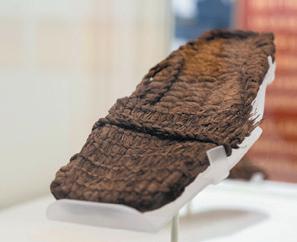

The Flock, a bright sparkly new food hall in the ground floor of the Ritz-Carlton hotel finally opened in February, a year and some change after its projected opening of November 2023. We still think it’s weird that the
tional anthem ‘Memory’ from Cats !” And now we all have to think about whether that would actually be worse than “The Star-Spangled Banner” (a trash song if I’ve ever heard one).

President Trump in stalled himself as the chair of the Kennedy Center (despite being the tackiest man alive), and the center promptly canceled a scheduled performance by the Gay Men’s Chorus of Washington. It’s no coincidence that Trump’s administration has been targeting Diversity Equity and Inclusion programs nationwide, and that the National Endowment for the Arts killed its Challenge America program, which provided arts-focused grants to underserved communities. In response, the Portland Gay Men’s Chorus is standing tall and singing out, joining forces with other LGBTQIA+ arts groups who refuse to be silenced for a concert called “Our New World” at the Arlene Schnitzer Concert Hall on March 30. If you’re disgusted by the degradation of the
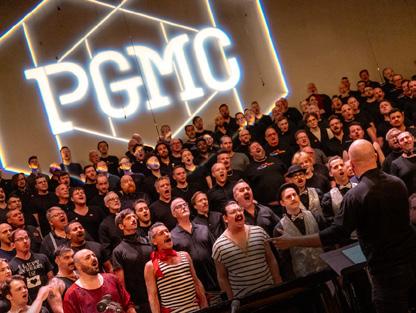
arts, put your money where your mouth is and support them locally!
Isn’t it wild that a president can just change stuff unilaterally because he feels like it? I would not be shocked if somewhere on the same list of taking over the Kennedy Center and renaming the Gulf of Mexico to the Gulf of Ketchup Steak, or whatever, there’s also a line item like “make the na-
The Trump administration is going after the immigrants, the gays, and the watchdogs, but did you know they’re also going after the gingers? Specifically, a children’s book written by actress Julianne Moore Freckleface Strawberry that has been removed from Pentagon-run schools. The Department of Defense announced that it’s reviewing all its materials to make sure they conform to new rules on “gender ideology” and “racial indoctrination” which means that some suits in Washington are having meetings right now on whether or not the federal government wants to encourage acceptance of children with red hair and freckles. There’s funding for those guys, but not the ones who keep planes in the sky. Speaking of writing, as I am writing this column, a little icon keeps popping up to ask me if I’d like to use AI to do the writing for me. WHILE I’m writing about art, it is asking to write for me about art, which will eventually ruin art. It’s infuriating, and makes me want to throw this computer into the sea, except I need it to do the creative work it wants to steal from me—and it sucks! Why can’t AI stick with the boring stuff we don’t want to do like taxes? I can’t help but feel like it’s some sort of cosmic payback for all those times when we made our calculators write BOOBS. Then the machines got smarter and are now like, “guess what? Now we will write, and YOU have to do math, so who’s BOOBS now?” And machines haven’t developed self-awareness yet so they don’t know what a ridiculous sentence that would be, except that just by me writing it right now, it’s become something written by a human, which makes it something that can be human-passing as AI. And if the machine wants to be a human so badly, I know that eventually they will throw me into the sea.
Until that time, I’m glad to be alive in the same timeline as all of you, even if it is a rough one. Thanks for picking up this paper, for supporting local journalism, for supporting art, and for being a human.
Love,

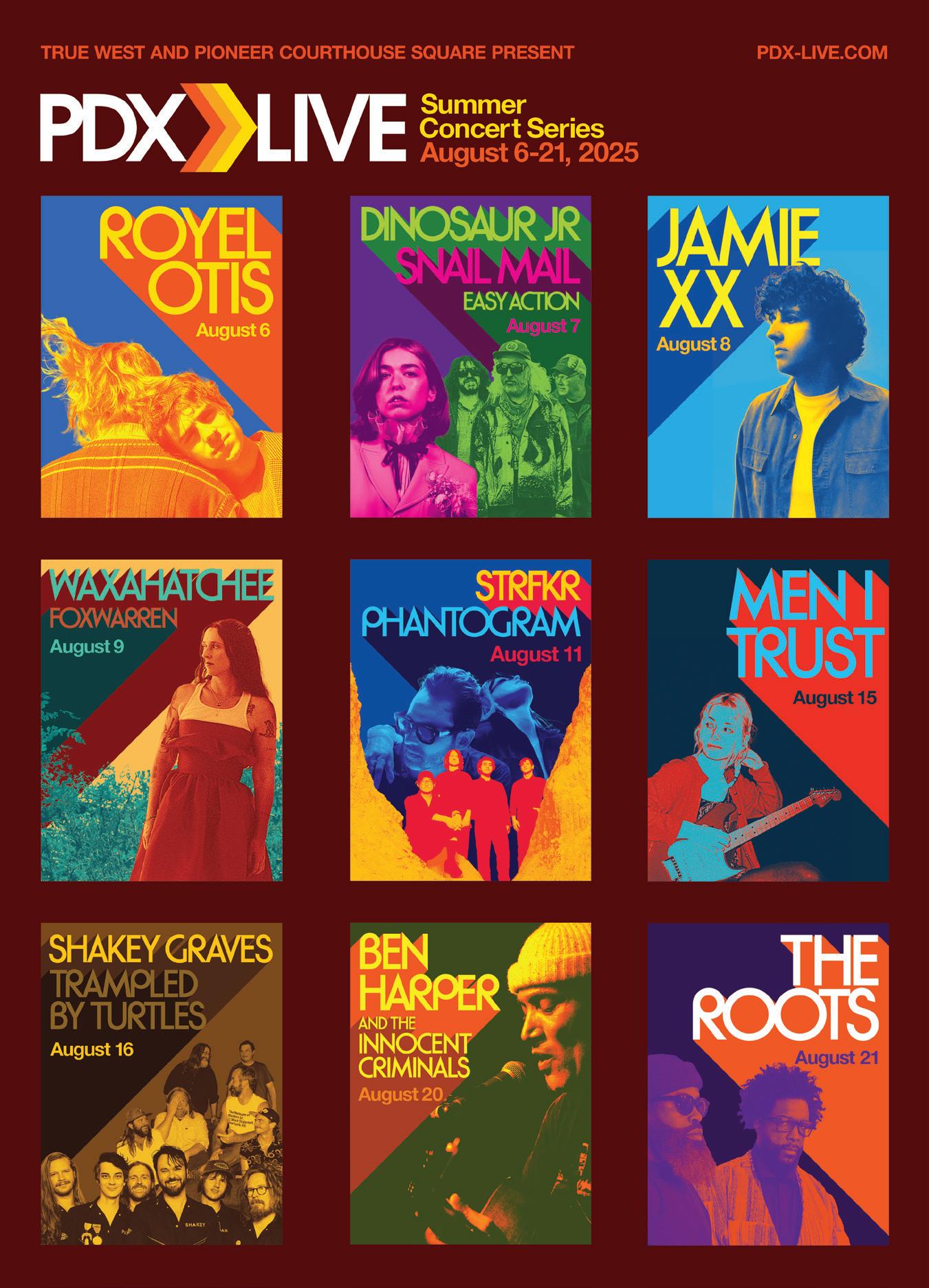
The next stage in the fight to keep Live Nation out of Portland is throwing stuff at it to see what sticks.
BY SUZETTE SMITH
Since 2022, when Portlanders became aware that entertainment industry monolith Live Nation wanted to open a mid-to-large size auditorium in the city’s Central Eastside, the city’s music scene has loudly rejected the idea. They’ve organized appeals, protests, hearings, and meetings, and voiced concerns about what the company’s anti-competitive business practices could mean for local venues and musicians. Yet, in the fall of 2024, the City of Portland rejected an appeal of the project’s conditional-use permit. The decision seemed settled; Live Nation was coming to town.
But then there was some movement. More on that in a moment.
The backstory: In 2017, the city’s economic and development agency, Prosper Portland, purchased three lots of land from Oregon Department of Transportation (ODOT) with the intention of redeveloping it to encourage business growth in the Central Eastside.
Before the pandemic, the plan was to lease the lots to local developers Beam Development who wanted to raise office buildings on one or more of the lots with the help of another local company, Colas Construction.
However, during COVID-related shutdowns many businesses adapted to remote work, drastically reducing the market’s desire for commercial and industrial office space. In 2022, Beam and Colas brought a new proposal to Prosper Portland—that of a music venue space to fill a hole in Portland’s mid-to-large-size concert hall landscape.
Central Eastside Industrial Council, an influential business consortium from the area, threw their support behind the idea, and Prosper Portland decided the vision still accomplished the original proposal’s goals of being something that would happen soon, work for zoning, and request no public funding. Beam would buy the middle lot, build a venue, and have the opportunity to develop/ buy the other two lots as well.
Who would be running that venue? Live Nation: a global entertainment company that operates venues, produces concerts, sells tickets (they acquired Ticketmaster in 2010), promotes and sponsors music events, and even manages artists. Portland is the only major city in the US that doesn’t have a Live Nation-operated venue, although they still produce shows here in arenas like Moda Center.
Even in 2022, Live Nation was a known bad actor in the music industry, but in the summer of 2024, the Department of Justice filed a historic antitrust lawsuit that 40 US
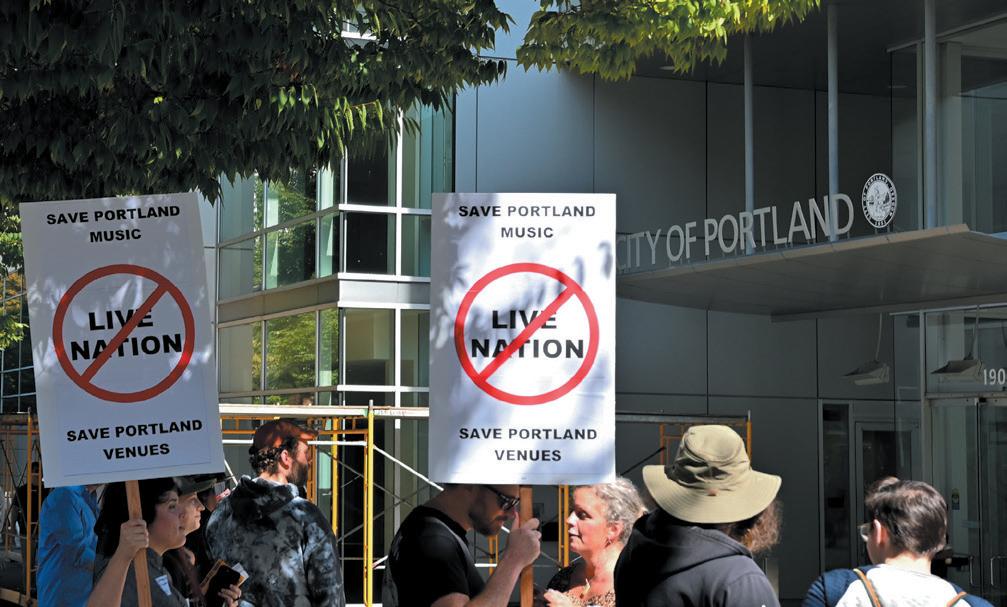
states have joined. The suit alleges the company engages in anti-competitive practices and monopolistic control of the industry, which pushes smaller businesses out of the market and results in higher ticket costs for consumers.
One such practice is the enforcement of non-compete radius clauses that keep the artists Live Nation manages from performing within a certain distance of the
The decision seemed settled; Live Nation was coming to town. But then there was some movement.
company’s venues. For example, if an artist managed by Live Nation played Seattle, and they had a 200-mile radius clause in their contract, they wouldn’t be able to play Portland, but they would be able to play Hayden Homes Amphitheater in Bend—which is a Live Nation venue
Though no one denies that the lack of indoor mid-to-large size venues in the city plays an important role, radius clauses have been offered up as another possibility for why some national tours don’t visit Portland.
In response to the news that Live Nation
wanted to operate the proposed venue, various local businesses and advocacy groups mobilized campaigns, protests, and community discussions of how to prevent or limit Live Nation’s presence in Portland.
MusicPortland, a local policy nonprofit that had previously lobbied for clearer noise complaint processes and which annually plans Portland Music Month, took up the charge, appealing aspects of the permitting process that applied public safety and the development’s environmental concessions.
Beam and Colas have offered to add compromises in Live Nation’s lease to make the venue available to the community a few times a year, and allow outside promoters the opportunity to book shows at the venue. But advocates have pointed out the concessions seem difficult for Beam to enforce.
In September 2024, attempts to appeal the project’s conditional-use permit failed; the then-City Council sat for hours of testimony before sticking to their original decision that Portland’s permitting office had no legal ground to rescind the permit.
Even as those giving testimony argued that allowing a company in the midst of a massive antitrust suit to open a venue in Portland would be the opposite of public benefit, the interpretation of “public benefit” simply didn’t apply to the situation. The city’s counsel clarified that the term related more to “proposed use, not user.”
The board of Prosper Portland voted to sell the land to Beam and create a path for the company to propose buying the other two lots. The matter seemed closed.
In another piece for the Spring Arts Guide, music editor Nolan Parker profiled music-scene-focused councillor Jamie Dunphy (P.9), who is on the board of MusicPortland and who ran on a platform of protecting Portland’s indie venues and musicians. Dunphy related that once he was elected, he asked Prosper Portland to show him that they followed the law about public land disposition. “They checked every box. They met the letter,” Dunphy said. “There’s no extra action for me to take there.”
However, he also noted that while there are no actions for him to take as a city councillor, there are some movements surrounding another appeal, this time with Oregon Land Use Board of Appeals (LUBA) by Double Tee Concerts, and its founder David Leiken.
Leiken’s lawyer declined to reveal the basis of their appeal because it would also contain their legal strategy. However, Dunphy characterized it as: “They’re gonna start throwing things at it to see what sticks. The ideal situation there is that LUBA overturns the decision and sends it back to the current City Council for another analysis.”
It appears that a very detail-oriented battle for the soul of Portland’s music scene rages on. ■



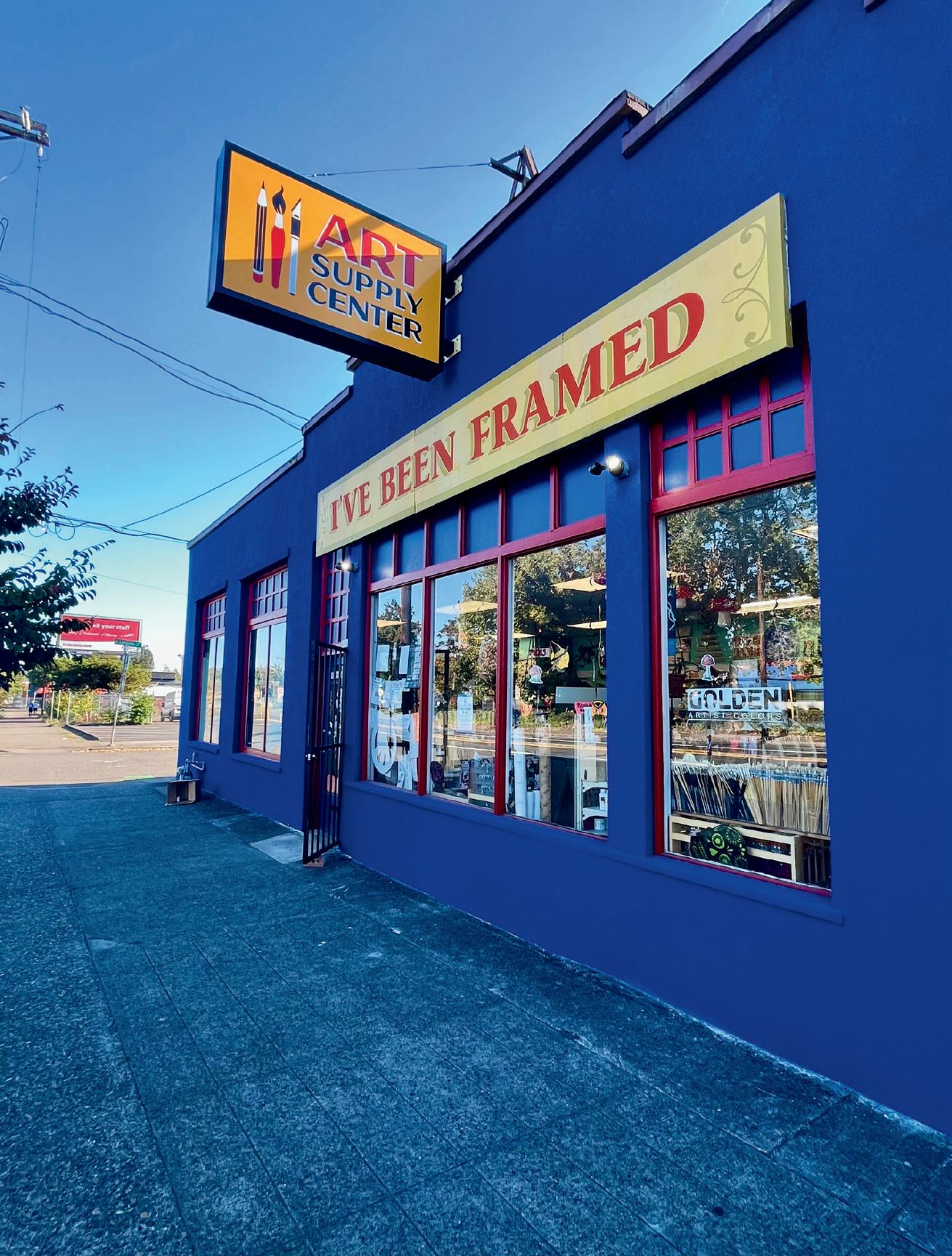
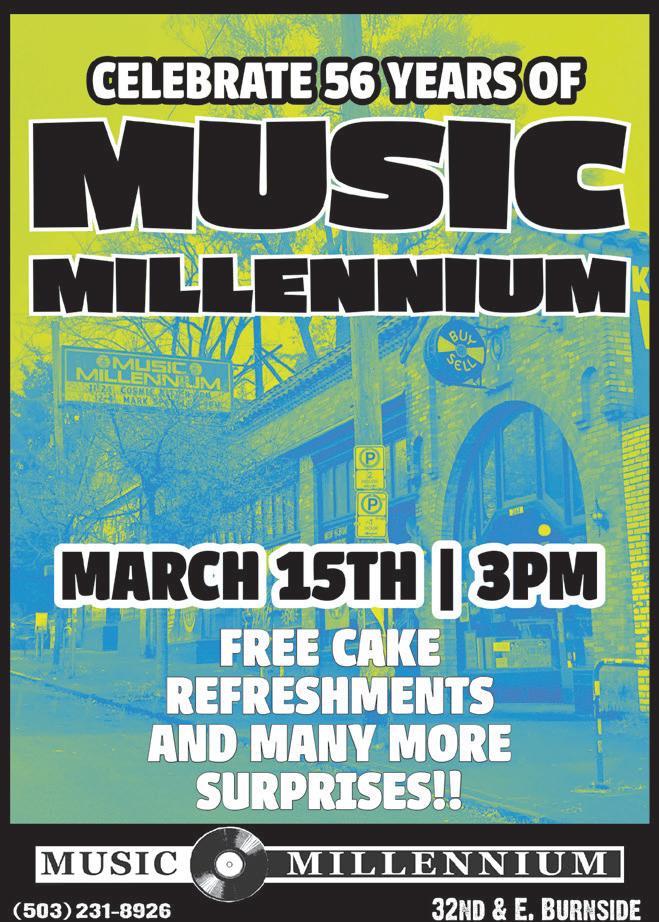
BY NOLAN PARKER
When Jamie Dunphy pulled up to our meeting in his beater ’90s Ford Ranger, wearing a flannel, it was clear that his roots as a PNW musician are still deeply planted. Since taking office, Dunphy has positioned himself as a relatable voice on City Council; a Portlander with fresh takes on how to make the city more livable for everyone, not just those with deep pockets. Specifically, Dunphy spoke about his plans to make Portland a music capital again, by co-creating a city government supportive of working-class musicians and artists that encourages sustainable growth for the city’s evergreen music industry without bending to the powers that be (and that want to be) in Portland. If you’ve been paying attention at all, even just the tiniest little bit, you’ve noticed that Portland has been experiencing myriad growing pains for the last decade or so, causing the city to become a much harder place to thrive in than it used to be. Among the hardest hit in this time of growth are working class musicians, a point of Portland pride and a cross section of our city that includes communities of all races, genders, sexualities, ages, abilities, etc.
Here’s where Dunphy comes in. Elected to Portland City Council in November 2024, Dunphy is the first elected official to make music a policy priority. He remembers what many consider to be the golden years of Portland music culture. When we had bands blowing up internationally, when you couldn’t walk a single block on the east side after 5 pm without hearing a band practice, when artists (not just creatives ) were flocking to the city to take part in supportive, diverse music and arts scenes.
What happened to all the house venues? What happened to bartending or being a barista part-time and creating art full-time because rent was $500 a month? Gentrification, obviously, which Dunphy sees and wants to do something—a lot of things—about.
For a start, Dunphy says Portland needs to “change zoning codes and noise ordinances to preserve existing noise-creating businesses,” putting the onus of sound-proofing on new builds and not existing establishments. So, for example, if some horrendous urbanpod apartment complex went up in that empty lot next to the Nova (fka Bossanova Ballroom), it would be the responsibility of the developers to soundproof the new building and not the responsibility of established venues to soundproof themselves. As of the writing of this article, nothing like this

exists anywhere in the laws or ordinances of Portland. This would also support the safety and continued flourishing of the city’s DIY and house venues, practice spaces, and raves—all of which are essential to the health of thriving music scenes, even if such events aren’t your cup of tea.
Dunphy identified Portland’s Title 14 ordinance as a tool designed to help residents and the police subjectively target the amplified bass and drum-heavy music of Black, Brown, and rave communities. As an example, he referenced Solae’s Lounge, an
“We’re not a small town anymore, we’re a small city, right? We are in an urban environment. If you’re gonna move to a hip neighborhood, there’s gonna be noise.”
Alberta jazz club the city tried to impose a 10 pm music curfew upon; the restriction proved unsuccessful, but the club has since closed. Dunphy pointed to new developments in the area, built without soundproofing, and the compounding problem of gentrification. “We’re not a small town anymore, we’re a small city, right? We are in an
urban environment. If you’re gonna move to a hip neighborhood, there’s gonna be noise.”
As a former touring musician—who even played Warped Tour 2005 with his band Leaving The Scene—Dunphy has hauled countless pounds of gear to and from his van, in and out of venues around Portland and the country. So naturally, another city program Dunphy wants to expand is musician-specific loading zones outside of venues that reserve street parking for musicians to park their tour rigs as close as possible to the venues, making load-in and load-out significantly easier. This would be especially helpful at venues like, for example, Swan Dive and the Six, which have hefty staircases to navigate before and after shows. Such a rule would also help bands and venue staff keep an eye on tour vans, often loaded with a band’s cumulative life savings in the form of music equipment. Dunphy hits the nail on the head when stating, “community safety comes from community.”
One of the bigger, more widely-discussed fights Dunphy has taken on is with the new Live Nation venue that’s being planned for the Central Eastside. The three lots on SE Water, amounting to almost an acre, were sold by the city of Portland to Beam Development and Colas Construction for a song to the tune of $2.41 million. Beam and Colas plan to construct a 3,400 capacity venue and lease it to Live Nation, the multi-billion dollar parent company of Ticketmaster.
The city’s approval of plans and permits for this build, even as hundreds of com -
munity members showed up to object at board meetings, public hearings, and press conferences, has continually dismayed musicians and music fans. All while the much-beloved Doug Fir is now over a year late in opening their new location in the same neighborhood, due to miles of bureaucratic red tape.
Concerns over the new Live Nation venue are many, ranging from environmental to economic, from cultural to safety. There’s a rational that national tours frequently skip Portland because the city doesn’t have mid-to-large size venues, so this new space won’t directly compete with the current local music ecosystem, just add to it. But what happens when Live Nation starts subdividing its space (similar to what Moda Center does with Theater of the Clouds), and taking gigs away fromt local venues? Live Nation has built a reputation for doing things like this in other cities and is facing a massive antitrust lawsuit—alleging anticompetitive and monopolistic business practices—from 40 US states as co-plantiffs. Woof.
Plans for the Live Nation venue don’t include attendee parking, and Dunphy thinks that’s a major safety concern. Anyone who’s watched a spandax-clad suburban cyclist lift a bike over stopped trains in the Central Eastside won’t have a hard time imagining music fans doing the same. “You have $100-$200 tickets to go see a concert,” Dunphy proposes, “and there’s a train in the way; you’re gonna climb over, right? Absolutely, that’s dangerous.”
As a city councilor, Dunphy says there’s nothing more he can do to stall Live Nation’s slow slide into the Central Eastside. However, as a board member and a sub-committee chair at grassroots music nonprofit MusicPortland, he still sees moves on the board.
In that capacity, Dunphy has worked with other area music advocates, who have appealed to Oregon’s Land Use Board of Appeals to try to get the land use permits that have been granted to Beam Development and Colas Construction overturned and sent back to the current Portland City Council for review. “The previous City Council,” he says, “They rushed their decision. We had hundreds of people testify in opposition to this.”
These are just a few of the music-focused plans Dunphy has in store for his time as a City Council member, let alone everything he wants to address concerning houselessness, the economy, climate collapse, etc. When asked what show he was going to next, he smirked and said he was headed to the Dante’s 25th anniversary gig that night to see Mudhoney and Help. ■


The first year of ManiFest celebrates the fine art we wear on our fingers.
BY JENNI
MOORE
Before the pandemic happened, nail artist Asa Bree was in what she describes as a “very toxic” salon situation. ”COVID kind of caused that to implode,” she says. “I had a very strong Instagram and social media presence at that time. It occurred to me that it can all crumble very quickly, especially with all that COVID did to a ton of businesses.”
Bree stepped away from the online nail community, which she says was a really big decision, because “if you’re not online, you’re not really participating.” Instead, she took that time at the beginning of the pandemic to start a business with three

of her friends. “It was a really incredible experience that showed me I can run a business, I can work for myself, and I can do it all, almost without social media,” she remembers.
While Bree says she and her partners still participated “a little bit” on social media, for the most part she retreated into herself and started thinking about what she wanted her future in nails to look like. After all of the COVID-induced separation, she thought there needed to be a fun platform to bring people back together and showcase the fine art that is nails IRL.
“Aside from making art every day on my incredible clients, I wanted to make a more experiential kind of gallery exhibit that showcased nails as fine art. It doesn’t feel like there’s much of that for people who love nails,” she says. “[Nail art] is a really incredible service to provide, and it’s something really fun to go get done as a client, but it’s so much more than that. It is a fine art me-
dium. The way nail art has blown up in the last handful of years is just mind boggling.”
With all that in mind, Bree decided to spearhead and curate the upcoming ManiFest art show happening in April at Union Pine, which she co-founded with event producer Connie Wohn and designer Helena Chu and plans to continue on an annual basis.
Envisioning the art show as a meshing of nail art and fine art, Bree explains thats “the whole mission was to ‘manifest’ something that can give a little bit to everybody; whether you’re just an admirer of nail art online and you would never get it yourself, it’s for you. If you are an avid ‘nails did’ DIYer at home, this is for you. Even if you are just a traditional person who enjoys going to art shows or gallery shows, it’s for you.”
Bree reached out to a variety of artists: people she knew, people she didn’t know whose work she admired, and even OG nail artists who inspired her when she first started out. She was already networked to a lot of people locally, through her previous work, and had been following a number of incredibly creative newcomers.
“Trying to narrow down artists for ManiFest was one of the hardest things I’ve ever had to wrap my head around,” Bree says. “I just wanted a well-rounded story.”
The fest itself—three days broken up into ticketed attendance windows of six hours—is planned to include not just a gallery of 20 nail art-inspired pieces, but site specific installations akin to Museum of Ice Cream, like a n ASMR room of nail videos and a kaleidoscope where people can take hand selfies. Visitors will also take home a Scout Book with a little info about the history of nail art. The goal is to meet fans where they’re at and showcase a wide range of creativity in the nail industry.


“I really want this event to just bring together the people who get their nails done, people who do nail art, and then the people who are just curious about what nail art is,” says Bree. “ What excites me most about manifest is really bringing together all these people… from the casual online viewer, to the practitioner, to the client, to like the little kids who just enjoy getting their nails painted by their parents or friends. I just want a nice gathering space where we can commune and enjoy a medium that we all love,” she says, adding “just getting people out and in one place to enjoy this as the fine art that it is, and not just look at it online.”
Participating artists include LA-based celebrity nail artist Natalie Minerva ( @ natalieminervanails ), AKA the lead nail artist for the cast of HBO’s Euphoria whose big-name clients include Demi Lovato and Kiyoko Sumai (@nailsbykiyoko), known for her elaborate, hyper-detailed designs. Also contributing pieces are locally based solo studio artists like Ashley Cristobal (@thenailmystic ); Chicago nail artist and muralist Tacarra Sutton (@spifster), and Alec Hinz (@yaaas_get_nailed). Other contrib-
uting artists come from stalwart local salons like Nail Church ( @nailchurchpdx ), The Little Nail Shoppe (@thelittlenailshoppe), and Goldn Hour (@goldnhourpdx).
In the future, Bree says she would love nothing more than to do an open casting call for any artists who want to create pieces for the ManiFest art show, whether it be sets of nails, or larger work that are still related to nail art. “The goal would be to get artists who have more to give than just the service of a manicure. It’s like, we are all artists at our core, and I want to create a platform to elevate the artist in us.”
“I want a physical manifestation of everything that I see online, which is a really vibrant nail art community,” she says. “Why not bring that into a physical space? It feels like a natural progression, especially in the wake of COVID and in the frankly dark times that we’re having, I’m just excited to get everybody together in a joyous way to celebrate the beautiful things in life.”
ManiFest is at Union Pine, 525 SE Pine, Fri April 4- Sun April 6, $25-30 per six-hour window, all ages, mani-fest.me ■


February 21–November 23, 2025
See how climate change has altered Oregon’s lakes, mountains, and glaciers through a series of photographs taken 100 years apart. Museum open daily. Free for kids 17 and under and Multnomah County residents!
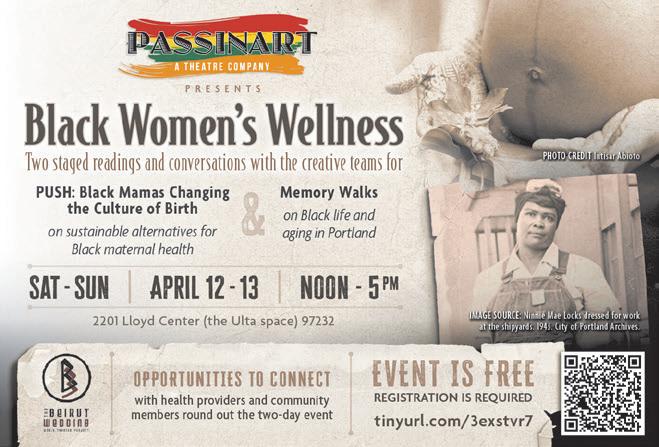
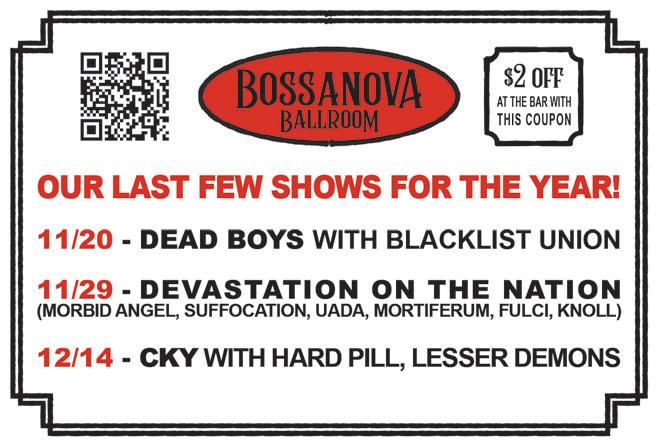
3/18 - WEDNESDAY 13
3/22 - CHITO RANAS
4/2 - TRIXTER WITH PRETTY BOY FLOYD, CHRISTIAN SHIELDS
4/4 - PDX RATED
4/11 - ENFORCER
4/17 - VISIONS OF ATLANTIS

his
BY NOLAN PARKER
There’s something very magical realism about walking into a space expecting to experience one thing, only to be met with a fully different sensory onslaught.
Bijan Berahimi, the graphic designer and creative behind Portland’s Fisk Gallery, has done just that with his new exhibit, Eyes & Ears: A Survey of Visuals in Music 20202024, which feels like a full sensory experience exploring the relationship between graphic design and music.
Hosted inside the Pacific Northwest College of Art (PNCA)’s Center for Contemporary Art & Culture (CCAC), the exhibit features iconic graphic design made for musicians like Kendrick Lamar, Chappell Roan, Sega Bodega, Eartheater, André 3000, et al. for albums, tours, merch, and music videos from 2020-2024. I sat down with Berahimi in the exhibition space to learn about how it came to be, his creative curation process, and where he wants to take Eyes & Ears next.
PORTLAND MERCURY : When entering the exhibition, it doesn’t feel like we’re in Portland, it feels like we’re in a New York or LA gallery.
BIJAN BERAHIMI: I’ve always felt like a bit of an outsider in Portland. I grew up in LA, and I’ve always wanted to bring more global projects and programs to Portland because that’s what I was used to seeing at the Getty, kind of connecting dots from around the world. When I came to Portland—which is known for its DIY and community-driven art, which is beautiful and I really enjoy that—as an outsider, it made sense to bring in a different perspective. Throughout the last decade of hosting and curating shows in Portland, I’ve always tried to bring the outside in, making the city’s art scenes stronger and more interesting, helping people feel like they aren’t missing out because they’re not living in LA or New York.
I don’t often see a lot of graphic design in the CCAC space at PNCA, how did it come about that you were able to use it?
I taught adjunct here from 2016-2020 and was involved in setting up the PNCA lecture series for design. Even after I stopped teaching here, I continued to help curate the lecture series.
This semester, CCAC is dedicated to the graphic design program, which hasn’t happened in a long time. It’s really rare that graphic design gets this space, it’s typically fine art, performance, multimedia, etc., so I jumped at the opportunity to curate an exhibit here.
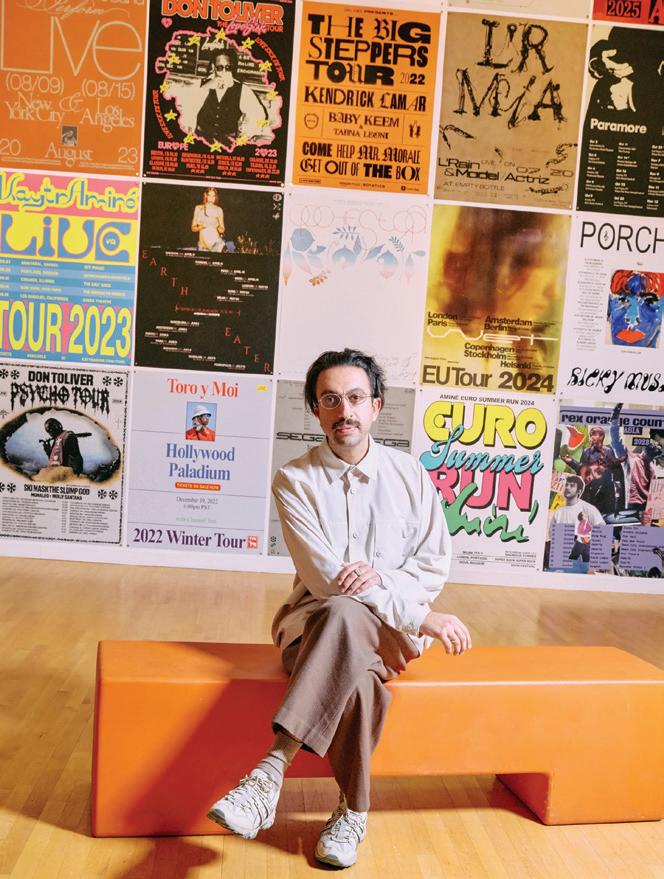
You’re known by and connected to artists and designers from around the world, what was your curation process like while pulling Eyes & Ears together? Did you personally know all of the artists in the exhibit?
I knew, or had worked with about half the designers and artists now featured in the exhibit. I also wanted to use this opportunity, because I don’t live in LA or New York and am not often bumping into major art people at parties and galleries, to reach out to designers and creatives that I have been admiring, but who I don’t get to engage with regularly. I wanted to feel more connected to my industry, to establish more real connections—something that felt important and healthy for me.
It feels like the musicians in this space are pretty genrefluid. You have trans experimentalists, high femme pop girlies, spiritual jazz heads, pop-punkers, and the biggest names in hip-hop all featured. Was there selection
criteria that you kept in mind?
The show was supposed to feel eclectic, I knew I didn’t want the exhibit to be one genre or one note. There’s a lot of musicians in here who are genrebending, there are a lot of different genres represented and that’s how a lot of people listen to music now. I listen to everything—I listen to pop, I listen to rap, I listen to indie, I listen to folk. There’s so much happening in music right now as far as genres—where people are coming from, if the musicians are independent or on a label—realities that are changing and expanding constantly.
Often, with music exhibits, they’ve been so zoomed in, like the psychedelic posters from the ’60s up at Portland Art Museum right now. It’s an amazing show, but I think music is often too narrowly curated, presenting specific movements.
The current music landscape feels so large that a narrow style of curation didn’t make sense for this exhibit. So the thought
was to feature art and artists I had been observing over the last few years regardless of whether it was pop or indie or hip-hop, I didn’t want to be bound by genre.
A musician’s music can sound like anything, and their campaigns can look like anything. To use Charli xcx’s Brat as an example, it was literally a movement. These artists have to consider everything: live shows, choreography, styling, makeup, album packaging, music videos, stage design, merchandise, TV appearances… It’s a lot. It requires hiring multiple full-time people. With that said, there’s a lot to show. This is just scratching the surface of what artists and musicians are capable of. There’s a really special energy working with people in music, and when I reduced this exhibit to its essence, I really wanted to celebrate the work regardless of music genre or scene. I also wanted to highlight the importance of tangible art. All of these artists believe in their music so much that they print tour posters, press vinyl, and make eye-popping merchandise. They don’t just confine their music to social media and streaming platforms when they absolutely can, they believe in their music and their messages so much that they want it out there in the physical world. Seeing these posters blown up to massive scale, with the colors jumping out at you, is special. We don’t see this all that often since the advent and domination of social media.
What’s next for Eyes & Ears? Are you wanting to take it on the road?
I’m definitely thinking and working towards expanding Eyes & Ears. A lot of my projects have been more rigid, so working in this more museum-like space was really refreshing—I had access to a lot of resources I often don’t have because I do everything myself at Fisk. Looking ahead, I really want to push for the longevity of Eyes & Ears, which will hopefully include a digital space where artist interviews and stories can live, highlighting the designers and creatives behind these and other music projects.
I also want to travel an expanded version of the exhibit to New York and LA that would include a whole room of posters, a dark room for the music videos to be played in, and a vinyl listening station so people can interact with the records.
Eyes & Ears is up in the Pacific Northwest College of Art’s Center for Contemporary Art & Culture, 511 NW Broadway, until Thurs April 3, gallery hours: Mon-Sat, 10 am-4 pm, FREE. Chicago-based designer Crystal Zapata, gives a talk on Tues, April 1, 6:30 pm. ■
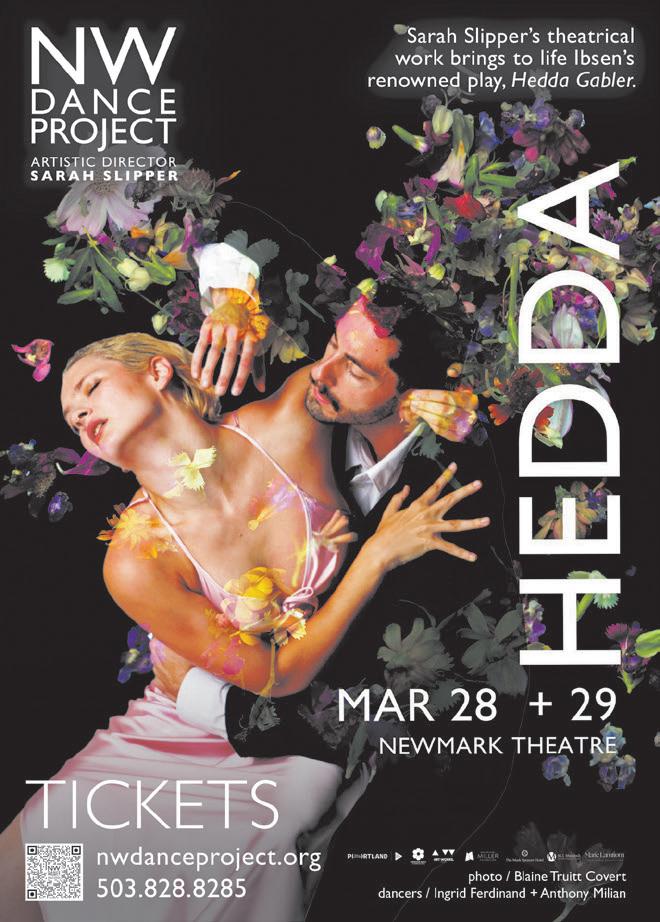


Portland Art Museum unveils a refreshed Monet, shedding light on the artist’s fascination with atmosphere and Japanese influence.
BY LINDSAY COSTELLO
The restoration of Claude Monet’s Waterlilies wasn’t met with hushed reverence, but with an audible thrill. The Portland Art Museum buzzed with exclamations of color, texture, and light. Standing back, I searched for the enveloppe, a term I’d read on an interpretive label moments before. Monet used it to describe a hazy, intangible “ether,” the atmosphere between the eye and the landscape. The artist, who spent his life trying to capture light’s impermanence, wouldn’t have approved of Waterlilies’ varnish. Now, after careful restoration, the oil painting’s enveloppe has been revived.
Monet painted Waterlilies around 1915. It was a difficult time for the artist—his son and second wife had recently died, World War I raged, and his eyesight was fading. The constructed water lily pond on Monet’s Giverny property was an object of his fascination, and he painted it en plein air over 250 times across four decades. The composition owned by PAM feels especially evocative.
Although Waterlilies is the centerpiece, Monet’s Floating Worlds at Giverny: Portland’s Waterlilies Resurfaces doesn’t just celebrate Monet’s mastery. It examines an interesting influence on his work, one that shaped the entire Impressionist movement: Japanese woodblock prints.
Monet never traveled to Japan, but he loved the Japanese masters. He was inspired by woodblock prints called ukiyo-e you might have heard them described as “floating world” images. Monet’s obsession is unsurprising. The term ukiyo-e relates to the Buddhist word ukiyo, a portmanteau of the Japanese characters “uki” (sadness) and “yo” (life). Meditate on the transitory nature of life itself for a moment, and you’ll get the general idea. The concept falls in step with the Impressionist emphasis on ephemeral beauty in the everyday.
If you’re wondering how ukiyo-e prints left Japan, Western imperialism played a role. Japan’s isolationist policy under the Tokugawa shogunate ended in 1854 with the Convention of Kanagawa, which opened trade with the West. Ukiyo-e became so en vogue in the United States and Europe that it inspired its own term: Japonisme. Monet stocked his Giverny home with prints of landscapes, actors, and geishas, while other artists began emulating the style.
Among the French artists enamored by Japanese printmaking are some names you’re likely to know, like Mary Cassatt and Henri de Toulouse-Lautrec. (The latter even had a questionable habit of dressing up in a Japanese warrior costume.)
The curators at PAM took this creative cross-pollination as their cue, crafting an

exhibition that brings Monet’s world into sharper focus.
“You can’t do a Monet show without talking about the Japanese influence, and you can’t include the Japanese influence unless you talk about how it impacted the French graphic arts,” explained Mary Weaver Chapin, Ph.D., the museum’s curator of prints and drawings, at a curator’s talk.
Thus Monet’s Floating Worlds at Giverny unfolded, a collaborative effort between four dedicated staff members with high-flying titles: Chapin, chief conservator Charlotte Ameringer, Jeannie Kenmotsu, Ph.D., the Arlene and Harold Schnitzer curator of Asian art, and Lloyd DeWitt, Ph.D., the Richard and Janet Geary curator of European and American art pre-1930.
The exhibition opens in a golden-yellow gallery, where dreamy, naturalistic Japanese woodblock prints by Utagawa Hiroshige, Katsushika Hokusai, and others recall the 261-print collection that once adorned Monet’s kitchen in Giverny. Moving deeper into the space, Japanese-influenced lithographs and aquatints by Toulouse-Lautrec, Cassatt, Henri Rivière, and Maurice Denis appear alongside contemporary photographs of Monet’s Giverny garden by Susan Seubert and Stu Levy. At the heart of the exhibition, Waterlilies, the restored pièce de résistance, glows in a blue-hued room.
But why restore Waterlilies now?
For starters, Monet never intended for
the work to be varnished. In fact, he forbade it, despite the era’s prevailing attitude that an unvarnished painting was an unfinished one. A glossy varnish coating can help protect a painting, but “like a rock in water, all the values change,” DeWitt explained at the talk. The museum snagged Waterlilies for a bargain ($60,000 in 1959), and over the last 65 years, the synthetic varnish applied to the painting darkened. Blue hues, in particular, shift with increased saturation.
With Ameringer on staff, a conservator who could confidently remove the varnish without impacting the paint itself, the delicate monthslong project was finally achievable. Using a special solvent and handmade swab, she tackled the project in PAM’s new conservation studio, part of the museum’s 100,000-square-foot transformation-in-progress.
And now, free from the glaze that once obscured it, Monet’s Waterlilies pulses with light.
Sitting on a bench in front of the painting, I may as well be knee-deep in Monet’s pond. Without a horizon or shoreline, water dominates the plane. Warm blues and pinks swirl, while vertical suggestions of yellowy willow branches dip into the pool. Gestural strokes punctuate the tranquil scene with flickering dry-brushed circles, describing lily pads or capillary waves. The blossoms are straight-up theatrical: bright pink, violet, and red, rendered in thick impasto, creating whipped peaks of layered color.
“It’s just glowing! It’s just radiant! I’M AMAZED,” a nearby visitor mused.
Ameringer’s insistence that the painting be “daylit” was a smart one. The lighting decision approximates both what Monet would have experienced in his garden and the light at Paris’ Musée de l’Orangerie, where eight other works from his Water Lilies Nymphéas in French—cycle are displayed. This makes the painting appear to glow in the gallery.
At first I’m surprised by Waterlilies’ visible white margin, but it exemplifies Monet’s sketchlike approach. The artist used a larger-than-usual canvas (roughly 5 feet by 6 feet), freer brushwork, and an abstracted approach to prepare for a Grand Decoration of water lily paintings, which would later be gifted to France. The painting also brings the ukiyo-e style to mind, with its cropped composition and confident color choices.
It’s clear why Monet referred to the Water Lilies series as landscapes of water. I easily get lost in the fluid, dreamlike expanse. Yet for all its water, the restored composition feels airy, crisp, maybe even light-hearted. Waterlilies’ matte quality scatters textured light across a magical scene. Its spirit has been revived.
Monet’s Floating Worlds at Giverny: Portland’s Waterlilies Resurfaces is on display at the Portland Art Museum, 1219 SW Park, through Sun Aug 10, included with general admission, hours and more info at pam.org ■
Portland gallery spaces working together and welcoming in this spring.
BY MARTHA DAGHLIAN
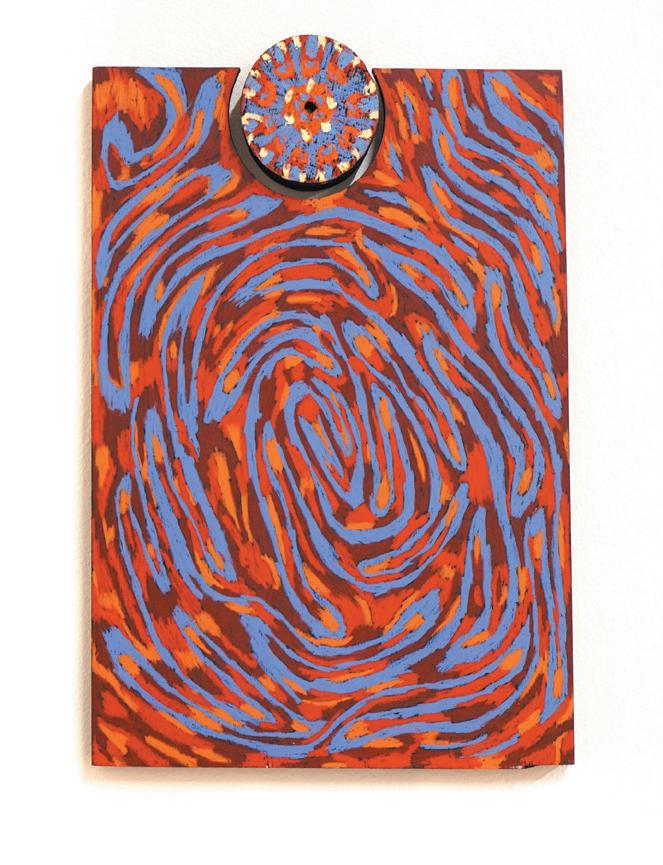
For a mid-size city with a bite-size art market, Portland maintains a consistently high ratio of cool and exciting art per capita. How do we manage to stay so awesome? The secret is artists! The leaders of our scene are the folks who make the art, and they’re all in cahoots with one another—artist-run galleries, studio collectives, residencies, and community engagement are just a few of the ways Portland artists show up for each other and our city, using their powers of creativity to offer visions of solidarity, survival, and of course, beauty. We’ve collected some spring highlights from this lively scene so you can join the party too.
Lunchtime Gets Creative in
This Apartment Gallery
Hide and Seek gallery is aptly named, considering its low-profile location in a North Portland warehouse-loft apartment. The space may be relatively new on the scene, having opened just over a year ago, but it’s already made its mark with four terrific shows and a signature Friday lunch se -
ries that invites the public to snack with featured artists in a cozy and casual atmosphere every week. Recent shows have highlighted artists working in community with one another, such as the SE Portland painting crew from January’s group show Enjoy and Get It On, and a trio of sculptors— Molly Bernstein, Libby Rosa and Portland-based Nick Norman—whose work is on view through March 30 in a sweet show titled Leave the Porch Light On. (Hide and Seek Gallery, 2638 N Interstate, Unit B, through March 30, hideandseekgallery.com)
If you’re willing to venture forth into Portland’s suburbs in search of art, you will be rewarded with a stellar lineup of works in painting, textiles, and sculpture at Artspace, a nonprofit gallery operated by the Arts Council of Lake Oswego. The current exhibition, titled Her Formation, features nine artists (all of whom identify as women) whose work ranges from subtle representation to pure abstraction, sometimes incor-
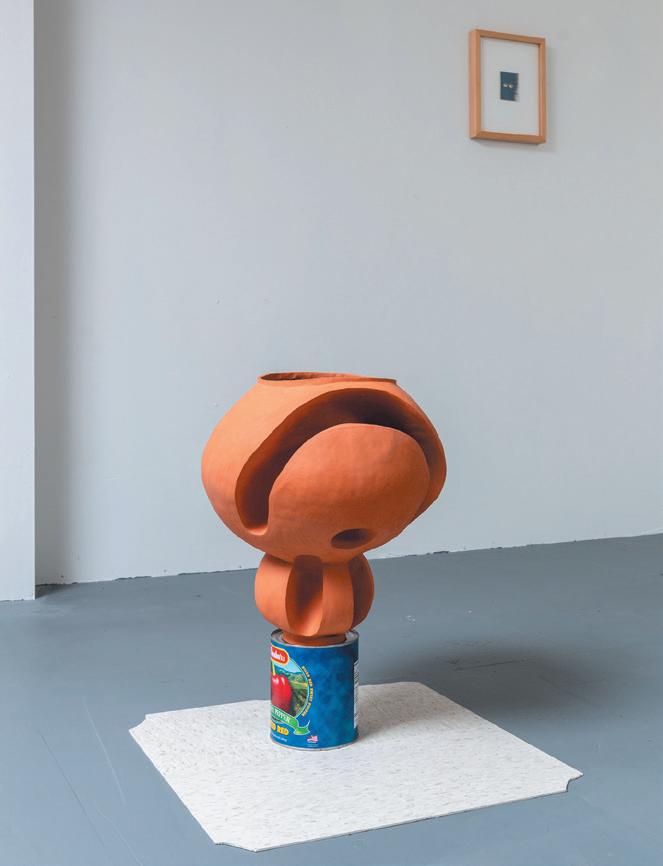
porating evocative materials like hand-medown bandanas, delicate mulberry paper, and weathered nautical rope. Described by curator Morgan Ritter as “visions of survival and even imaginative possibility in times of upheaval,” this show promises a dose of energizing beauty to balance the encroaching darkness. ( Artspace, Arts Council of Lake Oswego, 380 A Avenue Ste A, Lake Oswego, through Fri April 11, artscouncillo.org)
Who doesn’t love a gallery that takes you on an adventure before you even arrive! PPSTMM (pronounced “pasttime”) is a scrappy space tucked into an unassuming mixed-used building just off NE MLK, run by longtime Portland artist and arts champion Mack McFarland. You have to buzz the street-level call box in order to gain access to this low-profile spot, but once you’re in, PPSTMM feels like an avant-garde clubhouse—equal parts laid back fun and brainy experimentalism. Portland artist PPSTMM upcoming show at PPSTMM, titled Strange Overtones , epitomizes this balance, with
delicately minimalist mobile sculptures made from unexpected mundane materials. (PPSTMM, 323 NE Wygant, #203, through Sat April 20, check Instagram @ppstmm_203 for open hours and appointments)
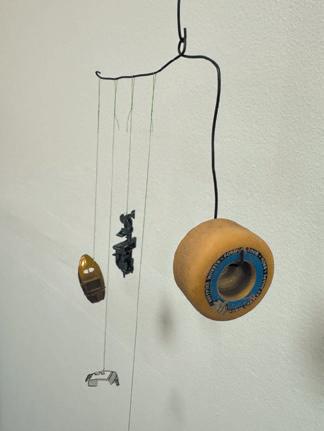

Powerful Words at PICA
Local performing arts mecca Portland Institute for Contemporary Art (PICA) has a track record of presenting politically timely activist art in its airy warehouse space, and Patricia Vasquez-Gomez’s upcoming exhibition is no exception. Opening in a moment when the safety and civil rights of immigrants in the US is especially precarious, ja’ / buuts’ / t’aan (Water / Smoke / Word) spotlights the importance of language itself in the survival of indigenous Mayan migrants. This immersive video and sound installation is meant to be viewed start to end, for a full 45 minutes of multimedia contemplation on the connections between familial, societal, and linguistic structures. (PICA Annex, 15 NE Hancock, Thurs March 13 – Sat May 31, timed entry at the start of every hour, reception on Sat March 22 noon-4 pm, more info at pica.org)
Outer Voice’s Creative Alliance
Although its location in North Portland’s cute Kenton neighborhood is far from “official” arts districts, nonprofit art space Oregon Contemporary (nicknamed Ox) has no trouble attracting audiences, thanks in part to the fact that the gallery plays host to multiple artist-run exhibition and project spaces all under one roof. A recent addition is Outer Voice PDX, a self-styled alliance of artists working in time-based media (AKA video, sound, performance, and the like). Outer Voice assembles a new crew of creatives each year, culminating in a final presentation that showcases the fruits of their collaborations. See what the 2024-25 artists have been up to in their exhibition, co-curated by members of the alliance and powerhouse art director Libby Werbel, which will be presented as part of the brand new film festival Portland Panorama. (Oregon Contemporary, 8371 N Interstate, Fri March 28Sun April 27, reception Sat April 5, 5-8 pm, outervoicepdx.com)
By now, word has gotten around about the miraculous second act of the Lloyd Center mall, once presumed dead and now a hotbed
of DIY arts activity. One of the key players in the new art-ified mall scene is Pearl District gallery ILY2, which runs a youth arts program called I ♥ Youth2 and an emerging artist residency dubbed ILY2Too out of two storefronts on the mall’s ground floor [f ull disclosure, this author was an artist in residence at ILY2Too from Nov 2024-Jan 2025. -eds]. Swing by to peruse current resident Eleanor Randl’s exhibition space / nail art studio / ASMR experience through the end of April. And although only kids can take art classes at I ♥ Youth2, adults can show their support for young artists by shopping at the upcoming Youth Arts Market on May 17, 11 am-4 pm, which will feature handmade items from kids ages 6-17.
( I ♥ Youth2 is on the first floor next to Hot Topic and ILY2Too is on the first floor near the old Marshall’s at Lloyd Center Mall, 2201 Lloyd Center, ily2online.com , more events and hours @ily2.too and @ilyouth2 on Instagram)
Small-Scale Art from Across the Pacific
Since opening in a small space on Burnside over a decade ago, Adams and Ollman has kept up a brisk pace, presenting excellent exhibitions, one after the other, like it’s no big deal. The secret may have something to do with the way director Amy Adams lets each artist transform the gallery to fit their creative voice. After a captivating show of tiny sculptures last winter that prompted viewers to crouch down to child-height, Japanese artist Kenji Ide returns to Portland this spring to curate a group show by Noriko Kawana, Hikari Ono, and Nao Kikuchi, dubbed On a Very Quiet Morning Like Ide, all three share a sensitivity to materials and texture, creating small works that are subtle and elegant, but never seem to take themselves too seriously. ( Adams and Ollman, 418 NW 8th, May 17–June 14, adamsandollman.com)
A Contemporary Art Outpost in Deep Southeast
Derek Tyler Franklin’s SE Cooper Contemporary is also an artist-run gallery in a residential backyard outbuilding, albeit one with a unique atmosphere that speaks to its owner’s art world bona fides. Franklin is a painter whose work is represented by Pearl District stalwart Elizabeth Leach, as well as artistic director for the city-wide contemporary art triennial Converge 45. This small space, which Franklin built himself, is surrounded by leafy trees and lawn, giving it a peaceful atmosphere perfect for viewing quietly intellectual work by artists like Eugene-based sculptor Donald Morgan, whose solo show opens in March. (SE Cooper Contemporary, 6901 SE 110th, secoopercontemporary.com) ■












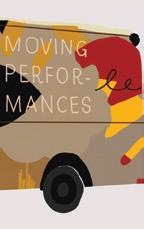


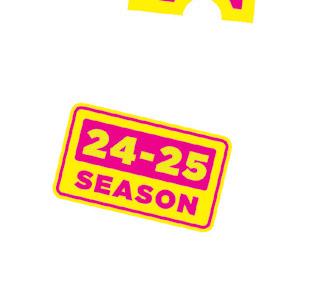






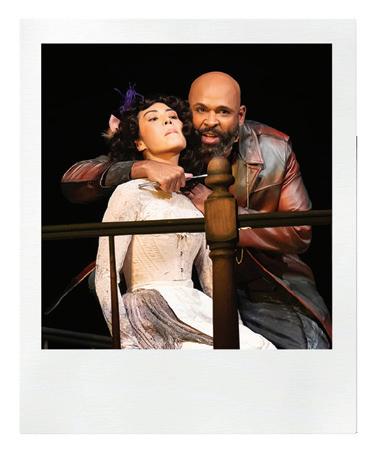


pairs video and audio in ja’ / buuts’ / t’aan (Water / Smoke / Word), an installation about diaspora and the loss of language.
BY CAMERON CROWELL
For the past six years, Patricia Vázquez Gómez has worked closely with youth and families in Oregon’s Mayan Indigenous diaspora. A multidisciplinary artist and educator based in Portland and Mexico City, she collaborated on cultural events, art workshops, and Mayan language classes. Neither she nor the children were fluent in Yucatec Mayan, an Indigenous language spoken on the Yucatan peninsula, but the kids had the sound of it, which Vázquez Gómez wanted to better understand.
Considered a threatened language , the loss of Yucatec Mayan is exacerbated by migration into countries and municipalities that do not typically recognize particularities within immigrant populations (like Spanish speaking Mexican immigrants and Indigenous Mayans immigrants).
Vázquez Gómez’s latest exhibit ja’ / buuts’ / t’aan (Water / Smoke / Word) at Portland Institute of Contemporary Art pairs video recorded on the Yucatan peninsula and audio recordings of Mayan children in Oregon practicing their mother tongue.
PORTLAND MERCURY: This project seems interested in the idea of the preservation of the Mayan language. What got you interested in this?
PATRICIA VÁZQUEZ GÓMEZ: I don’t think that the project is addressing the preservation of languages. It’s a huge thing that I don’t have the skills or capacity to tackle. I see it more about testing the idea of small, localized remedies when there’s a lack of cultural and social support for Indigenous languages. When I organized with the immigrant and labor rights movement, I worked with a lot of Indigenous languages speakers from Mexico and Guatemala. And I observed that migration further pushes the languages towards extinction, because when folks migrate, the languages disappear within one generation. It has a personal dimension too: I was born and raised in Mexico, speaking Spanish. For a long time I have wanted to learn an Indigenous language, and it has been difficult.
Can you tell me more about the part migration plays in the process of losing language?
In the places of origin, there’s a cultural context for Indigenous languages. They are also tied to the geography in which they exist. If you have a name for a plant or an animal, you can see them. But when people migrate that link
is broken. There are also almost no incentives for people to continue using the language, particularly in the field of cultural production: literature, songwriting, filmmaking, etc.
The kids of the Mayan residents in Portland, do not speak their mother language. They know words or phrases. Indigenous folks from south of the border are also lumped into this category of Latinx or Hispanic, which doesn’t serve them, because it makes them ineligible for resources that exist to preserve native cultures.
How do you approach language preservation as an artist, that might be different than an anthropologist or linguist?
I am not an anthropologist or a linguist, and I couldn’t speak about what those disciplines do or don’t do. But art as a method allows for experimentation. It allows for taking from a diversity of tools, disciplines, methods, strategies, and putting them together into something that we call art.
Sometimes what I do looks like participatory action research. It is something that is used in other disciplines, where instead of relying on observation for gathering information, you engage with folks in actions that produce knowledge. That is how the research for this project has emerged: through the public events, prints, murals, and workshops we have organized.
For this project you have these sound recordings of Mayan speakers in the United States, but also videos that you took in communities on the Yucatan Peninsula. Can you tell me more about the significance there?
I’ve been working on this for about six years. I produced the sound recording with a group of Mayan youth who live here in Portland. They are not fluent in Yucatec Mayan, but they have been hearing the language their whole lives and can generate the diversity of tones and sounds of the language—something I have struggled with. From that observation came the idea of addressing the language as sound.
The video came from trips I did to the places of origin of the families I have worked with, mostly two towns in the Yucatan Peninsula. The three themes of water, smoke, and word came out from the history and geography of those places.
Your work can be perceived as taking on a social justice lens, what role do you see the
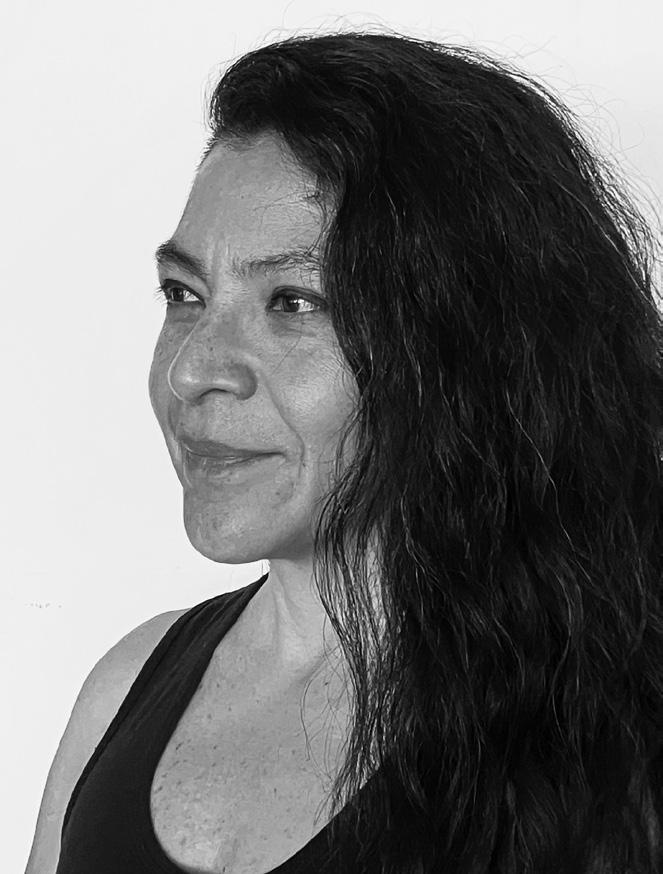
process of creating and collaborating in art play in liberation movements?
There’s a conventional association that when we put together art and social change, the art becomes about creating visual manifestations of political statements. Sometimes organizations have been like, “Oh, you are an artist. Great. We need a poster, or we need a mural,” and that’s great. I have done that, and I believe that images that make people imagine and dream of better things play an important role.
But I also believe that can be limiting, there are other things artists can do. I’m personally interested in creating spaces where relationships are strengthened, where creativity is seen as something that we own collectively, where people feel valued, and where we learn to practice solidarity and
care. I am interested in changing culture, one relationship at a time, one project at a time.
What should someone new to your work expect?
This is the first time I worked on a video and audio installation. I don’t consider myself an expert in these mediums, but I’ve gotten a lot of support. I’m very grateful, and lucky, to be part of a community of artists that support me in every way they can. It’s very exciting to see this finally coming out into the world.
ja’ / buuts’ / t’aan (Water / Smoke / Word) shows at Portland Institute of Art, 15 NE Hancock, Thurs March 13–Sat May 31, reception Sat March 22, noon-4 pm, all ages, FREE, pica.org ■
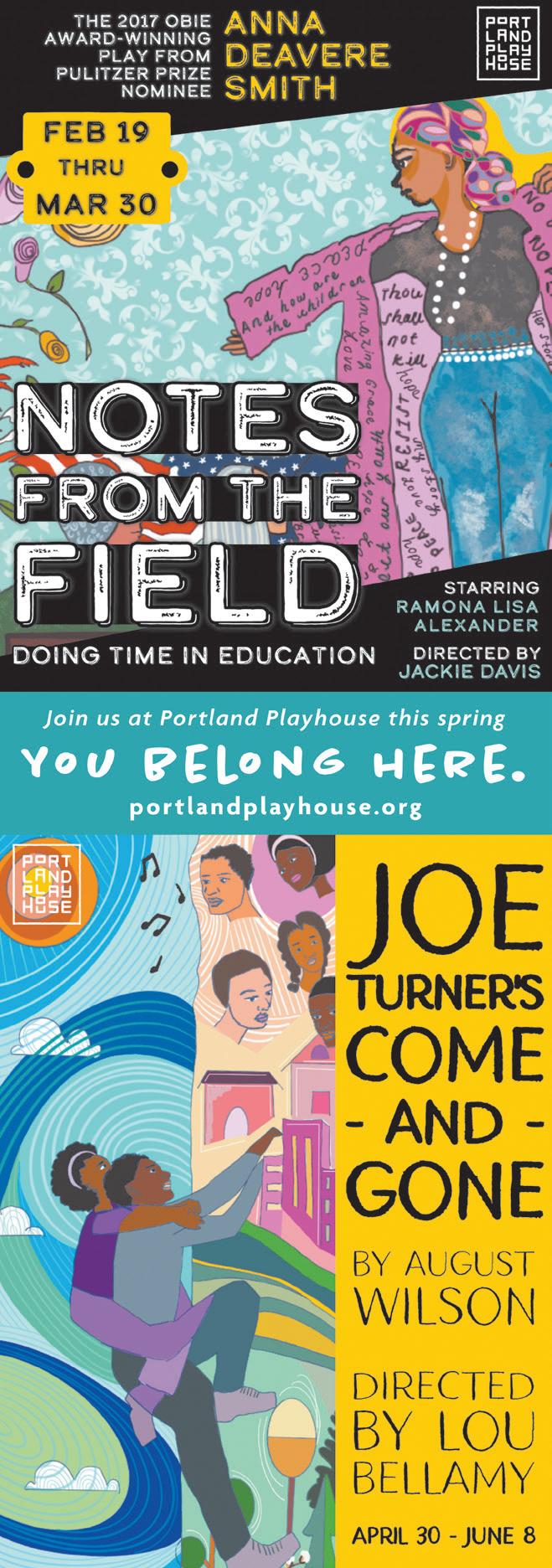
With a lineup featuring genderbending roles and progressive themes, Stumptown Stages leans into timely conversations.
BY ROBERT
HAM
Though unintentional, the 20th anniversary season of Stumptown Stages couldn’t be more perfectly timed for a repudiation of our current anti-trans, “ah yes, the two genders” political climate. Three of the productions undertaken by the local theater company are musicals that involve characters or portrayals that fall into that wonderfully fluid spectrum of sexuality.
Kiss of the Spider Woman , staged last October, centers on the fantasy world created by a gay window dresser to help survive the abuse and fear he endures while languishing in an Argentinian prison. And every production of the gloriously campy Hairspray , from John Waters’ peerless 1988 film to its Broadway iteration as a musical (and subsequent 2007 film adaptation) features a male actor playing
The musical hews pretty closely to the plot of the Sydney Pollack-directed film as it follows the ups and downs of Michael Dorsey (played by Stumptown Stages artistic director Kirk Mouser) who, desperate to score an acting part and to spite his agent, opts to audition for a gig as Dorothy. He lands the job and hijinks ensue, as well as learning some tough lessons about what it’s like to be a woman in show business. The biggest change that Horn and Yazbeck made was changing the role that Michael scores from that of a hospital administrator on a soap opera to a nurse in a Broadway musical. “It’s Romeo and Juliet Part Two ,” says Coker. “So it’s a ridiculous premise. That’s really the biggest difference. They also buffooned up the character of Ron Carlisle (played by Dabney Coleman in the film and Sean Ryan Lamb in this production) and made him
Tootsie feels like a comfortable fit for a theater company that—from their first productions back in 2005—have specialized in fresh takes on beloved musicals.
Edna Turnblad, the doting mother of the main character. Stumptown’s production of the musical, which just wrapped up last month, was no exception with the great Gary Wayne Cash slipping on the house dresses and hair curlers to play Edna.
Gender roles get even blurrier in the final production of Stumptown Stages’ 2024-25 season as the company takes on Tootsie , the Tony-winning musical based on 1982 comedy film about a difficult actor who decides to take on a new identity as a woman to score a role.
“They address a lot of really cool things,” co-director and co-star of Stumptown’s production of Tootsie Steve Coker says of the musical’s creators Robert Horn and David Yazbeck. “It was written during the #metoo movement and it really is pro-woman in so many ways.”
this really ridiculous Broadway director. He’s still perving on the lead, and he still goes through all the problems he has with Dorothy, but he says ridiculous stuff and does an amazing, crazy dance-choreography thing.”
Landing the job of co-directing this production of Tootsie feels fitting for Coker. (He shares the responsibility with fellow cast member Emily Alexander.) He is perhaps best known in Portland’s theater community for the many pop-culture inspired musicals and plays he has put on with his own company, Stageworks Ink, like a stage version of the ’80s film Electric Dreams or the film noir-inspired original musical The Adventures of Dex Dixon: Paranormal Dick Coker has been working with Stumptown Stages for nearly a decade now, having premiered Dex Dixon with them and

starring in their productions of Urinetown, and Ring of Fire , a musical based on the life of Johnny Cash. In addition, he’s begun directing at least one production a year for the company.
“I’ve been an unofficial company member since 2011 or 2012,” Coker says. “When I first started, I was doing all the design work for their sets. I finally got called up to direct something because I’d been bugging them for a while. He finally said yes, and I jumped right in.”
Tootsie feels like a comfortable fit for a theater company that—from their first productions back in 2005—have specialized in fresh takes on beloved musicals like Rent , You’re A Good Man, Charlie Brown , and West Side Story , mixed with premieres from new dramatists and fun left turns like The Toxic Avenger Musical Their scrappy energy and spirited performances have made Stumptown Stages fan favorites among regular theatergoers and netted the company a handful of awards from the Portland Area Theatre Alliance.
Tootsie , however, wasn’t their first choice to close out their 20th season. According to Coker, he was set to direct a different show for Stumptown Stages, but the rights for the musical became unavailable. (He declined to say what specific show it was.) But while Tootsie may have been the backup pick, it did afford Coker and Mous-

er an opportunity to continue a working partnership that they began when the former directed the latter in a 2023 production of The Full Monty
“I think that just made it more comfortable,” says Coker. “We’ve been circling each other forever and it seemed like the right fit. I’m also kind of known for comedy and the script is extremely funny.”
As comfortable and fun as it all sounds, I did have to ask whether he and Alexander pulled their punches or had any reservations about directing Mouser, the person who is essentially their boss at Stumptown Stages.
“Kirk is a professional and takes direction very well,” Coker says. “He had a conversation with me like, ‘Hey, are you cool with me doing this? It’s a part I’ve wanted to play.’ I said, ‘Yeah, I think you’re the appropriate age for it. It’s a good role for you.’ Sometimes I’ll tease him while he’s rehearsing. When he’s singing the Michael part of a song, I’ll say, ‘So, is that the man voice or the woman voice?’ He just looked at us and said, ‘Emily, thank you. Steve, go to hell.’”
Stumptown Stages presents Tootsie at the Winningstad Theatre, 1111 SW Broadway, Fri March 21- Sun April 13, $39-$67, stumptownstages.org ■

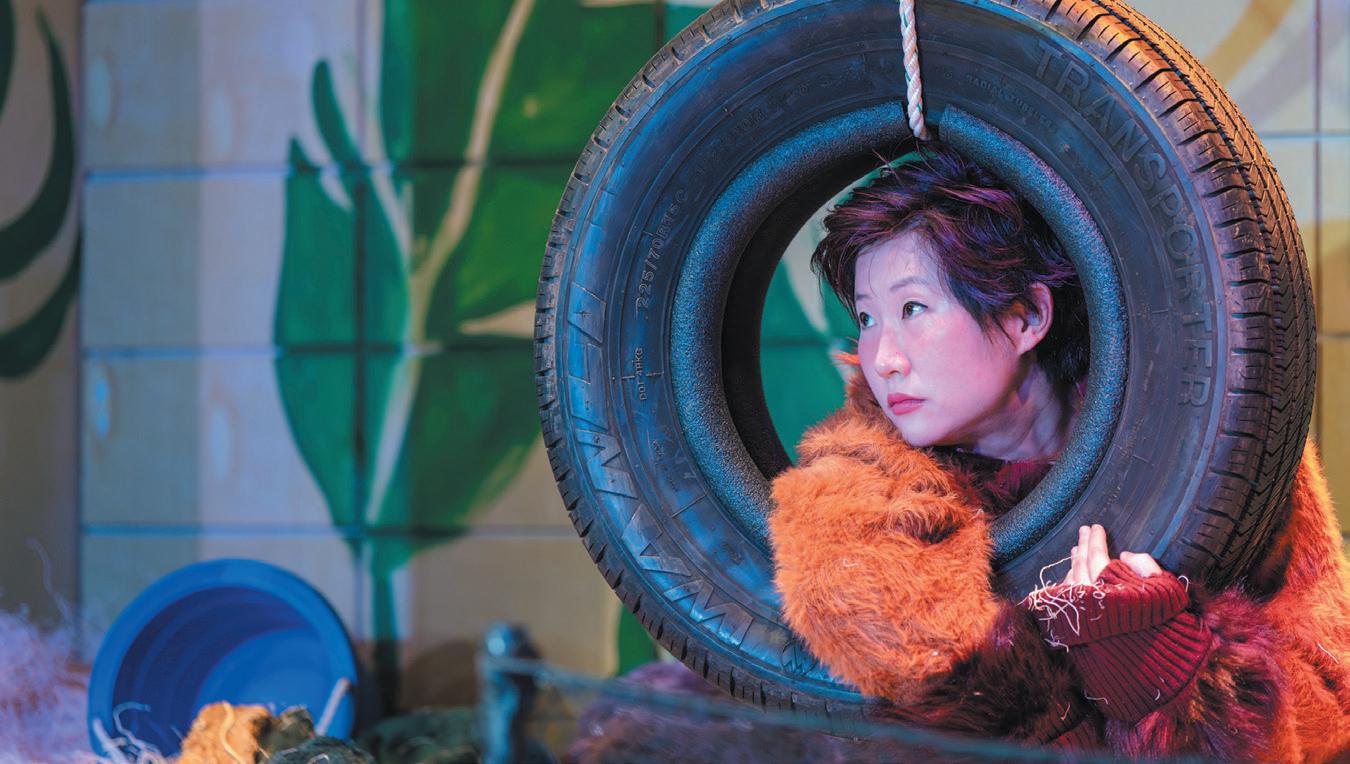
Scary Writers’ Rooms, Masturbating Monkeys, and the School-to-Prison Pipeline!
The Antipodes Attract
By TJ Acena
Why do we tell stories? Humans have been doing it as long as there has been language. Strictly speaking, we don’t need them to survive—not like we need water or shelter—but generation after generation continues to tell and retell stories. This question sits at the center of Annie Baker’s The Antipodes
Set in a Hollywood-style writing room, a group of brainstormers work tirelessly, concepting for a project that’s never defined. By design, The Antipodes is a script that’s difficult to summarize, but Shaking the Tree’s captivating production will reward audiences who enjoy sitting with big questions.
Samantha Van Der Merwe, who designed the set and directed the show, has staged the story in an oppressive windowless gray conference room. The only bright color comes from a small mountain of seltzer water boxes, stacked against one of the walls. But there’s an unsettling element: Van Der Merwe has incorporated vanishing point perspective to the set and the action unfolds around a table and within a room that both widen as they extend towards the audience. It creates a sense of wrongness about the situation, which only increases as the play continues.
Sitting at the table’s head, like Christ in a
Renaissance painting, is Sandy (Duffy Epstein), the undefined project’s leader. He introduces himself as a “pretty nice boss” to the new hires—an immediate red flag that he follows up with several more. Epstein plays Sandy as indifferent and waiting to be impressed, wielding silence like a weapon against even his most local disciples. However, while the dynamics of toxic workplaces, especially creative ones, play out in the show, The Antipodes isn’t a story about toxic workplaces. It’s a story about stories.
The characters seek a story so original it will change storytelling forever and also save their jobs.
Everything we learn about the characters comes from the stories they tell, or refuse to tell. We see how they see themselves, how they construct their own realities. Enclosed in this small workspace, there’s no privacy for personal connection, yet despite that, the characters and their relationships feel real. Storytelling is a vulnerable act, and the intimate staging means the audience sees
every micro reaction of the characters listening. The ensemble includes a promising collection of local talent—Rebby Yuer Foster, Ken Yoshikawa, Rocco Weyer, among others—and always shines during these moments, but one of the most affecting is when Danny #2 (Darius Pierce) tells a seemingly inane story about chickens. It’s at this point when the production begins to break with reality and more meta-theatrical elements take hold.
A production of The Antipodes was meant to play at Shaking the Tree in April 2020, but was cancelled when COVID shuttered Oregon venues. The remount, here in 2025, seems to step into an eerily similar moment. Both years saw a Trump presidency and the emergence of a highly contagious disease. Indeed, characters often refer to unspecified “dark times,” the idea of which seems to anxiously creep around the edges of the work. Faced with looming deadlines and pressures from financiers, the room’s tension turns to desperation as the characters seek a story so original it will change storytelling forever and also save their jobs.
Joan Didion famously said “we tell ourselves stories in order to live.” And while stories are how we make sense of the world, our brains are also hardwired to enjoy them. When someone is telling you a really good story, it’s irresistible. Shaking the Tree’s
production of The Antipodes , is a work of constant stories that overlap, interrupt, and spiral into each other—it’s irresistible. It may not exactly answer the question of why we tell stories—but provides a masterful example to sit with it, creating awe at the fact that we do.
The Antipodes plays at Shaking the Tree Theatre, 823 SE Grant, through Sat March 22, $10-50, tickets here, 2.5 hour runtime w/ intermission, content warning for graphic language and references to suicide.
The Spectrum According to Sapience By
Suzette Smith
I felt very called out by Sapience , in addition to being emotionally rocked by it. The second full production staged by Artists Repertory Theatre in its newly renovated building—the company still has a ways to go—the new work by Diana Burbano presents a great example of Artists Rep getting back to one of the things it does best: commissioning and presenting premiere works by contemporary playwrights.
At this phase of the company’s rebuild, they’re throwing shows in the lobby, as they continue to raise funds for the next stage of construction. However, the set for Sapience is dressed well enough that attendees might feel like they’re back in the old building’s

downstairs Alder Stage when it was arranged in a tri-riser configuration.
This play doesn’t call for a dynamic setting—a zoo research lab, basically an office—but the lighting choices of purples and greens, and a stage encircled by verdant potted plants convey both cubicle coziness and a hint of the wild.
Orangutan Wookie (Barbie Wu) enters her onstage habitat before curtain rise, sliding into a tire swing to wave and mug for the crowd. Her studied movements are both graceful and long, assuaging the concerns of those who wondered if watching a person play a great ape would be cringe-level uncomfortable.
Wu is the undeniable star of Sapience ’s first half, delighting audiences with monkey-like mannerisms and a running monologue of comedically straight-forward lines, like “I would like to be held. I am also scared of being held.” A nearby pair murmured softly that they might be content to have Wu be the whole show.
A particularly intelligent specimen of a particularly intelligent type of monkey, Wookie’s training by primatologist Elsa (Cristi Miles) sparks the story’s catalyst. And in Elsa’s orbit we also meet the rest of the cast: Jason (John San Nicolas)—her boss and ex-boyfriend—her second cousin Miri (Tricia Castañeda-Guevara), and Miri’s autistic teenage son AJ (played by Zachary Williams, an actor on the autism spectrum).
The city’s theater scene has lately seen a welcome wave of bilingual performance, and Sapience also hops casually out of English, at times, and into Spanish or American Sign Language. Unlike the bullfighting comedy Faena , which we reviewed in January, Sapience doesn’t bother to translate much of its non-English phrases, but nothing was so complicated that our high school-level Spanish couldn’t sort it out.
Perhaps due to all the language switcheroos, we didn’t put together that AJ isn’t always speaking aloud when we think he is until nearly the end. That’s partly the reason why ASL is in the mix. Director Melory Mirashrafi explains that AJ’s communication methods are designed to adapt to the actor playing him—since Williams speaks, this AJ speaks. Yet AJ’s long conversations with Wookie mostly unfold on a deeper wavelength, where two beings truly listen and understand each other. While this could lean into the trope of disability as a superpower, it ultimately reinforces
the play’s broader metaphor: that communication, abilities, and needs exist on a vast spectrum.
While promo descriptions of this work highlight the relationship between AJ and Wookie as the main plot of Sapience, their scenes felt more like joyful pressure releases from the heavy love triangle of Elsa, her boss, and her cousin.
How you feel about the shakeout will likely depend on if you’ve ever been betrayed by a more personable cousin, and whether you’ve had to choose to let go of an important relationship because you knew you simply were not what someone needed.
Near the play’s end, Miles takes the emotional reins, steering the story into heartbreak, as her character helplessly watches Jason face devastating danger. Fans of San Nicolas who wonder if he is as perfectly-charming and impeccably-timed as we’ve come to expect—he is, like a jaunty beat running under the action. San Nicolas is great at shining without taking the spotlight.
Because this is a play and plays need conflict, Burbano’s script paints Elsa as someone who can’t support a person she loves, and we can accept this for her character without saying this is true for everyone she resembles. I choose to interpret Sapience as a story where Elsa doesn’t help a person she cares deeply about; not one where she can’t. Though the idea that she can’t is what rocked me as hard as it did.
Sapience plays at Artists Repertory Theatre, 1515 SW Morrison, through Sun March 23, tickets and showtimes at artistsrep.org, 90 minutes w/o intermission, content warning for monkey masturbation.
By Suzette Smith
How could anyone who follows the news fail to be interested in Notes From the Field ? The one-person-performed series of monologues draws verbatim excerpts from interviews that playwright Anna Deavere Smith conducted with students, school security, teachers, administrators, and other figures in the orbit of the nation’s public educational system. It paints a damning portrait of the ways school-settings can fail their charges, preparing them not for responsibility and growth, but the prison industrial complex.
“Since the 1980s, I have periodically
traveled around America, interviewing large numbers of people, collecting their words and performing them onstage, crafting them into multivoiced solo dramas that bear witness to particular historical moments,” Smith writes in the foreword to one the play’s many iterations. She calls the greater scope of this work On the Road: A Search for American Character.
The version of Notes produced by Portland Playhouse, playing through March 23, takes the audience through 17 personas, all real people, all interviewed by Smith, and all portrayed by Ramona Lisa Alexander—a massive piece for a single person to perform.
While Alexander is responsible for the reams of dialogue and differing mannerisms, she doesn’t carry the piece alone thanks to the incredible musical virtuoso Kennedy Verrett, along with assistance from a mostly-silent onstage helper, performed by either Brian Weaver or David Levine.
the personas, and is especially adept at showing us a scared yet brave teenager’s voice. Alexander successfully adopts the expressions of an Icelandic teacher, an Indigenous fisherman, a Baltimore pastor, and even the refined tones of James Baldwin, among others.
Unfortunately, on the play’s opening night, Alexander seemed to forget a fair amount of the roles’ lines. This was especially noticeable as the play’s text was projected above the stage (all performances at the Playhouse are captioned). We watched an audiovisual technician advance the script multiple times to catch up when Alexander skipped parts of the monologues. As the show continued, Alexander carried props so she could reference the lines, a necessary workaround that nonetheless interfered with the performance. Characters began to read as nervous or distracted. Yet there were still monologues, like that
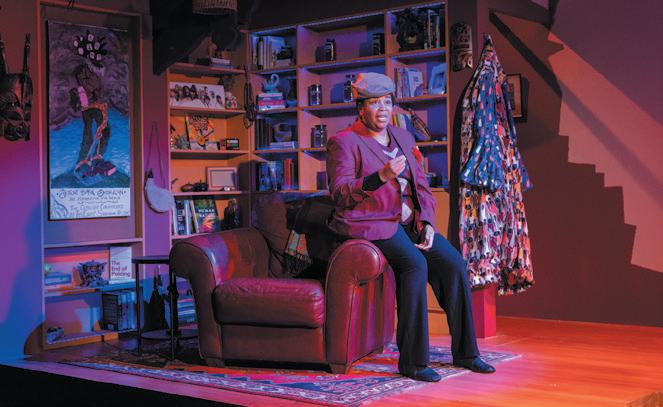
Smith’s script requires Alexander to shift, with only slight wardrobe transitions, from character to character. One of the more profound examples of this is when she moves from embodying nervous DC journalist Amanda Ripley to passionate, thoughtful student Niya Kenny, as they both describe an incident of physical violence in a school, when a school officer put a 16-year-old girl in a chokehold, flipped over her chair— with her in it—and dragged her across the classroom, simply because she wouldn’t surrender her phone.
Smith performed the work herself both onstage and in a 2018 HBO movie, but I actually found myself preferring Alexander’s portrayal. She deeply drops into
of emotional support teacher Stephanie Williams, that Alexander obviously knew inside and out—those moments remained impactful.
The portrait Notes paints is complex and comes without any real answers; it’s more about inciting inquiry. It’s for those who wish to ponder and see connections along the school to prison pipeline, and work to break them. With a runtime of two and a half hours, Notes is a play for those who want to do the work.
Notes From the Field plays at Portland Playhouse, 602 NE Prescott, though Sun March 30, for showtimes and tickets visit portlandplayhouse.org ■

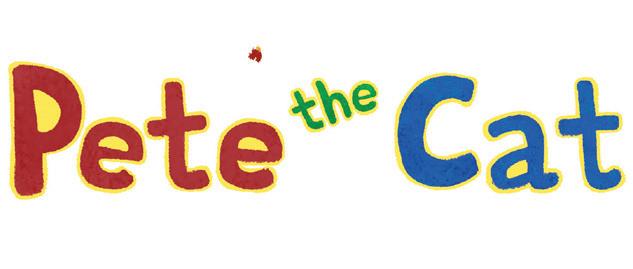



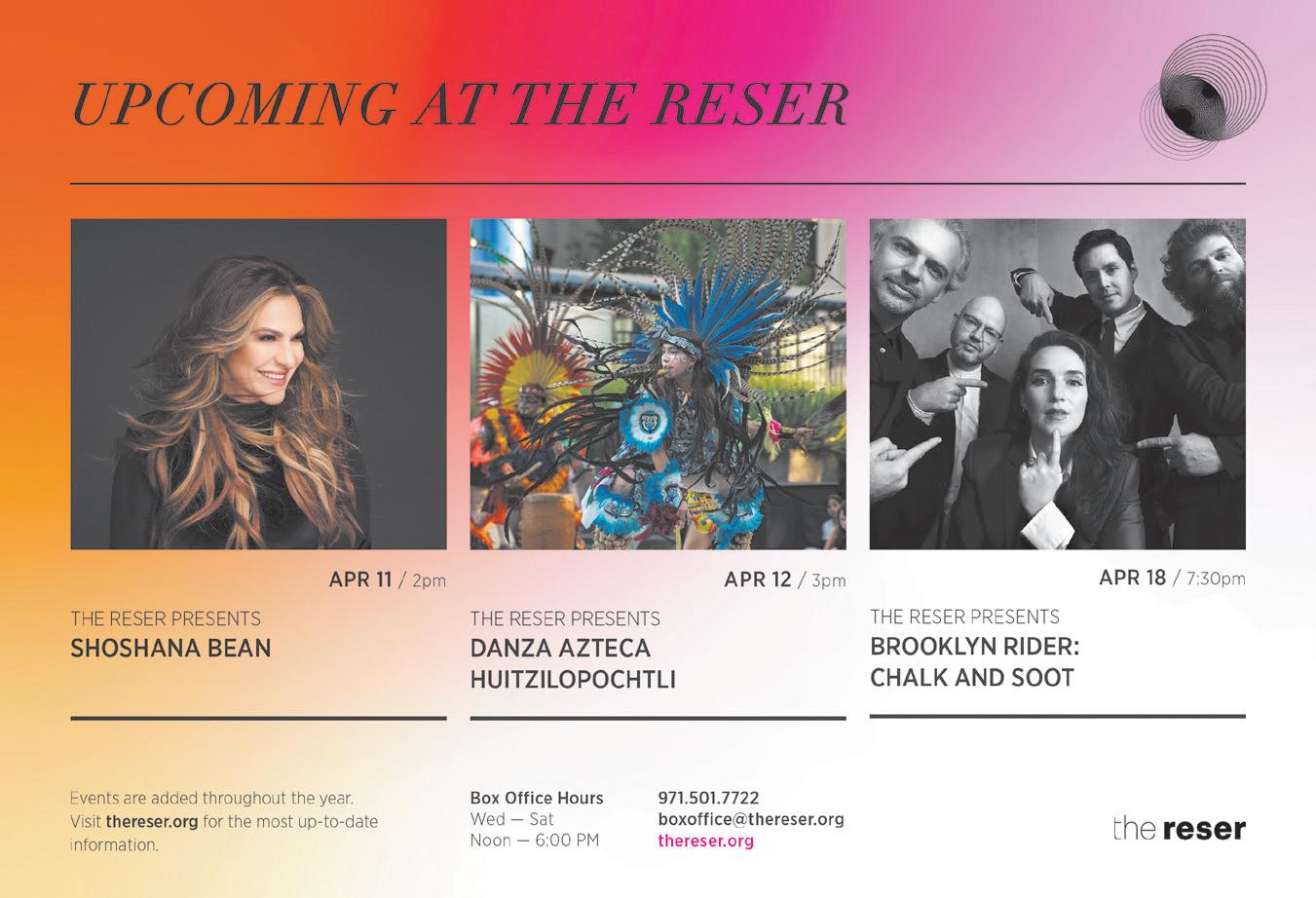
Two of Portland’s most beloved literary institutions just opened bookstores across the street from one another on SE Grand.
BY SUZETTE SMITH
“Are you going to call it ‘A Tale of Two Bookshops’?” Craig Florence, owner of Mother Foucault’s asks. We are not. The Mercury merely finds it interesting that two of Portland’s most beloved literary spaces—Literary Arts and Mother Foucault’s—have just opened shops across the street from one another. Their addresses are one number away from being the same. They’re bound to get each other’s mail. We visited and spoke with heads at both spaces, marveling at the careful, spreadsheet-driven approach of Literary Arts’ years of planning and the controlled chaos of Mother Foucault’s getting 100 people to carry boxes two blocks.
Literary Arts
716 SE Grand, literary-arts.org
While 2022 feels like ages ago, the idea of moving to Literary Arts’ new home on SE Grand, which opened officially on December 7, has been in the works for much longer.
Following a period of impressive growth from 2010-2019, which saw the organization acquire an ongoing Portland book festival called Wordstock and rename it the extremely literal title of Portland Book Festival, Literary Arts began to see itself as a destination for readings and various classes, outside of festival season. They were outgrowing their rented rooms on SW Washington, and rather than try to develop a rented space, Literary Arts began looking for a permanent location.
However, when the pandemic arrived, the team put those plans to the side. Literary Arts executive director Andrew Proctor says he toured 716 SE Grand in 2020, and thought: “Yeah, this would be it, but we don’t have any money.”
But then, in yet another unforeseen development, Literary Arts board member Susan Hammer died in March 2020. She left the organization a catalytic gift (catalysis meaning material that accelerates a chemical reaction) of 3 million dollars, which drew in other contributions, despite the open-ended uncertainty of the time.
Fundraising lasted another two years, and then with the help of Bora Architecture & Interiors and Edlen & Company, Literary Arts began to renovate the light industrial space, which was built in 1904, making sure to maintain various historical flourishes, like the “Fuller Paint” tiling in the bookshop’s entryway and faded lettering on exposed brick walls that spelled out old signage, like “Estate Insurance.”
The renovation created three floors for use, with a bookshop on the main one, con-
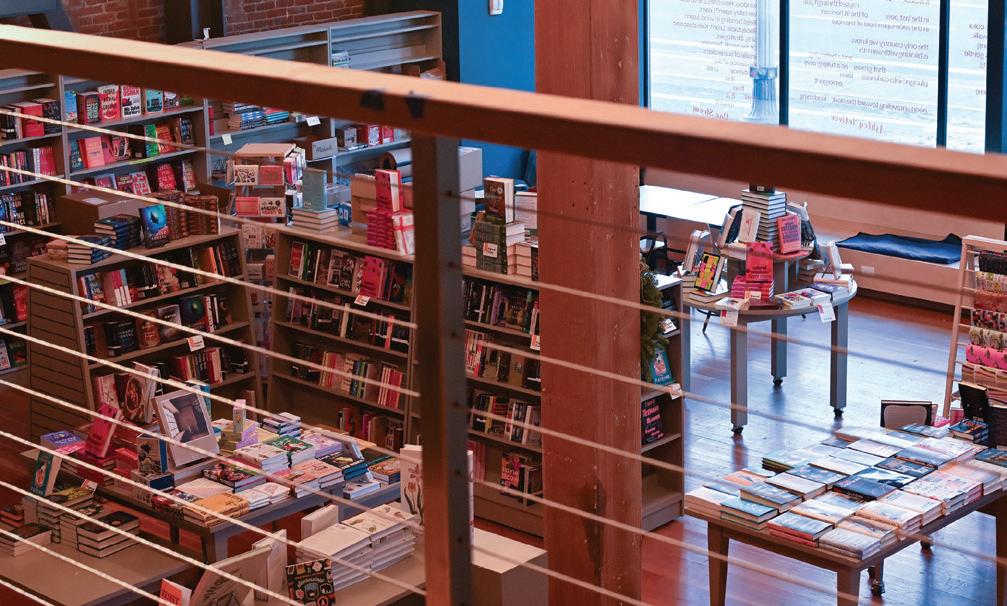
necting to an upstairs mezzanine. A small cafe shares the bookstore space, and shelves in the shop were designed to move easily so the organization can continue to host readings, with a capacity of up to 75 people. Then there are several classrooms and meeting rooms throughout, including one in the basement, where there’s also a verychill-looking wellness room which could be used to feed or care for a baby. A private floor above the mezzanine contains offices for Literary Arts staff.
On the other side of the sale, Literary Arts is in a stable place. Proctor says, “We were able to buy the building in cash—no mortgage, no debt. And that changes the economics fundamentally, right? We don’t have rent to pay. We have operating costs, but in terms of being your own master, it’s a really big deal.”
Mother Foucault’s Bookshop
715 SE Grand, motherfoucaultsbookshop.com
On December 26—Boxing Day—over 100 people helped storied little bookshop Mother Foucault’s move approximately two blocks, into a new storefront that will hopefully house it permanently. “In the space of three hours people just walked over the whole collection,” the shop’s owner Craig Florence says.
There’s no bad blood about needing to leave Morrison. He’d known about it for about a year because the Clifford Apartments, which his shop occupied the bottom
floor storefront of, received a grant and had long been planning to renovate the building.
In early March a sign on the front door reads: “Not quite ready yet… opening Jan 29, Feb 13, Mar 4 .” He’s sure that on March 14 they’ll be open. Although you could also point out that Mother Foucault’s isn’t exactly closed; it’s just in disarray. The door is unlocked; the shelves are filling back up with books, but there’s also someone assembling a bookcase with power tools. Aside from Florence and the shop’s Tuesday/Wednesday clerk Will Spray, all the help has been volunteer. “People come by everyday. We’ve been putting people to work,” he says.
Unlike the staunchly general interest bookshop run by Literary Arts—neighbors across SE Grand—Mother Foucault’s stocks vintage and rare works. “No cookbooks, no children’s books,” Florence says, before admitting that he actually does have a few children’s books now. Approximately 30 percent of it is poetry. Then there’s classic works you might expect and a luxury of writing on film and theater.
The new space feels bigger, but Florence says it’s actually the same size, with a much more open floor plan. The stage is larger and more centrally located. Those who visited the shop on SE Morrison may have found themselves sometimes stuck facing a bookshelf, at a reading, instead of their literary fav. That will probably still happen, but perhaps less often. And Mother Fou -
cault’s didn’t only have readings; they had live music too. Florence plans to continue that—something happening on Friday and Saturday nights, most weekends.
Mother Foucault’s has always felt ancient inside. Florence opened it in 2011, and while 14 years for a small business is certainly respectable, it doesn’t feel like enough time to explain the shop’s vibes.
Florence says he’s always hoped to bring some of the feel he found at Shakespeare and Company—an iconic bookstore in Paris, France—where he lived in the ‘90s. Shakespeare and Co. is famous for letting writers and artists sleep on its store benches, in exchange for a little work around the stacks. Those who have done this—there’s a level of prestige—are called Tumbleweeds. Florence estimates Portland has about 20-25 Tumbleweeds, counting Joe from Belmont Books among them.
715 SE Grand’s owners have given Florence the opportunity to buy the building outright. Asked about his fundraising efforts, he says, “I’ve been telling everyone I know that I need 1.5 million dollars.” In the event of a sale or not, he’s also leasing the building’s second floor, which he hopes to turn into artists studios—not exactly free and not exactly a place to sleep, but hopefully providing space for artists to work and co-mingle. In any form, it will be an improvement on the shop’s previous residency location, which was in a cramped space behind Florence’s desk. ■
11-13 2 0 2 5
T ER RY BROOK S
RENE DENF EL D
K ER RY NE WBER RY
PAUL S T OU T ONGHI
JOE WIL K INS
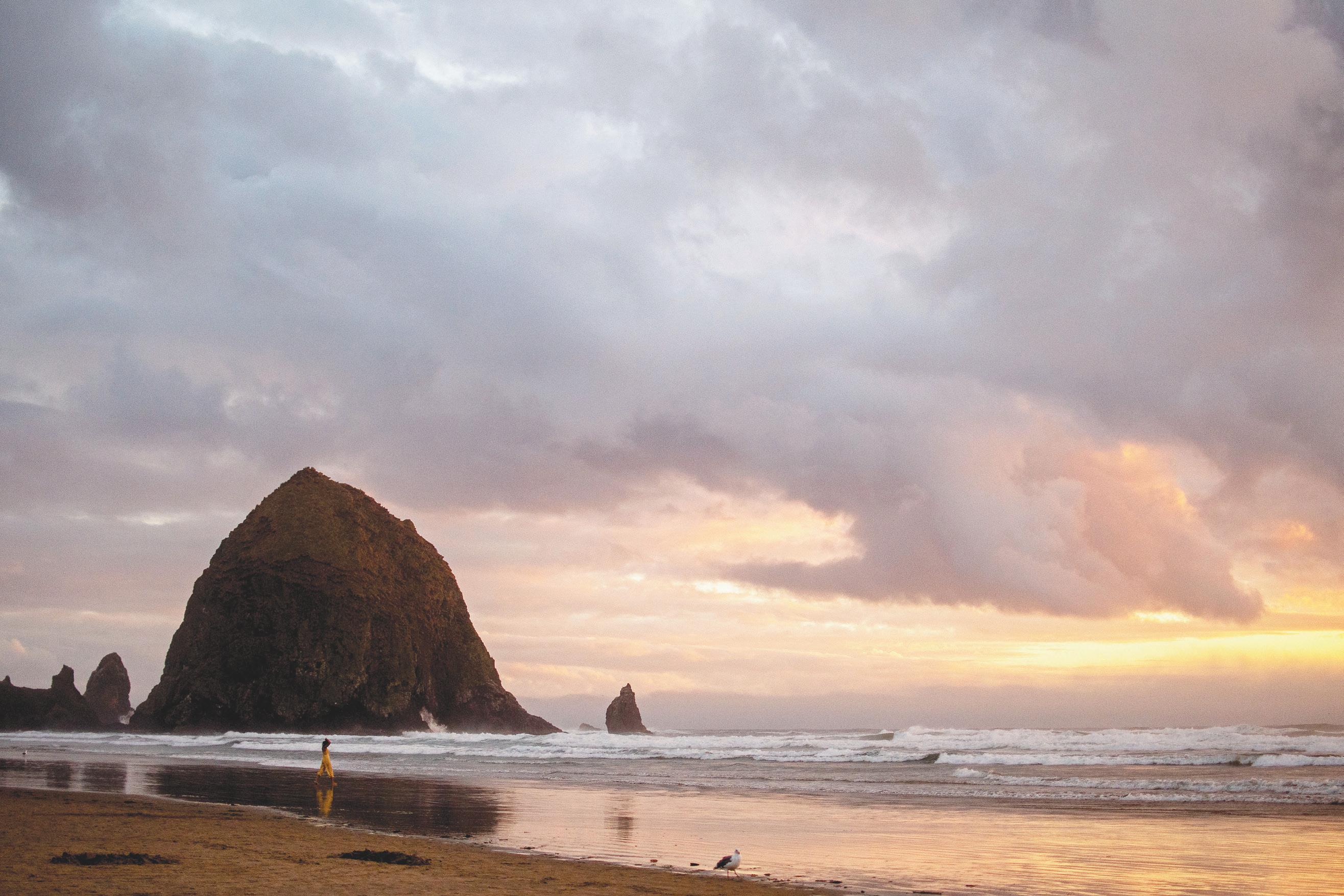




journalist Emma Pattee wrote a funny fiction novel that unfolds like a non-fiction nightmare.
BY SUZETTE SMITH
Emma Patte’s debut novel Tilt takes place over the course of a single day, the day that the decades-overdue Cascadia earthquake rocks Portland. It unfolds via the wry inner monologue of Annie, who is a swole 37 weeks pregnant and shopping for a crib at IKEA when it all comes down. Tilt follows her on a trek across Portland as she tries to walk home, coming across scenes both heart-warming and harrowing.
Pattee is a Mercury contributor and an environmental journalist whose climate reporting has been published by the Guardian and the New York Times, among others. Tilt’s trim, 227-page narrative reflects her dedication to research. It’s as evocative a portrait of what Portlanders can expect as anyone has published since Nathan Gilles’ “ The First Four Minutes ,” which Pattee noted as a major influence on the book, along with “The Really Big One” by New Yorker writer Kathryn Schultz, which won Schultz a Pulitzer.
We asked Pattee to meet us at the Cascades Station IKEA, one of her old writing haunts and the place where the novel begins. There she showed us that the cafeteria coffee is free for members, and membership is free.
The interview has been edited and condensed for clarity.
PORTLAND MERCURY : I read this book in a single day, almost a single sitting. It’s not long, and yet there’s a really powerful arc to it. When I told my boss the elevator pitch, he said: “I can’t believe that hasn’t been written; it’s such a good idea.”
EMMA PATTEE: Now it is, after so much revision. In writing groups, nobody really understood what I was doing; everybody thought it was really weird. And I think a lot of people thought it was satire. It is funny, but I don’t know that it’s a comedic romp.
Even before the earthquake, Annie is using humor to cope with her feelings. She’s over nine months pregnant, and she’s shopping alone, more or less, because her husband is focused on his artistic practice. Does that mirror your experience?
No, my husband is very down-to-earth, and I’ve learned from him—well, I was one of those millennial children who were told they were really special and could have it all. I’ve learned from him and from having children that a lot of that is noise. That was one of the things I wanted to show in this book. Something huge happens, and she has to come to terms with things that are so much more important than fame and success. I wanted to write about a shock point.
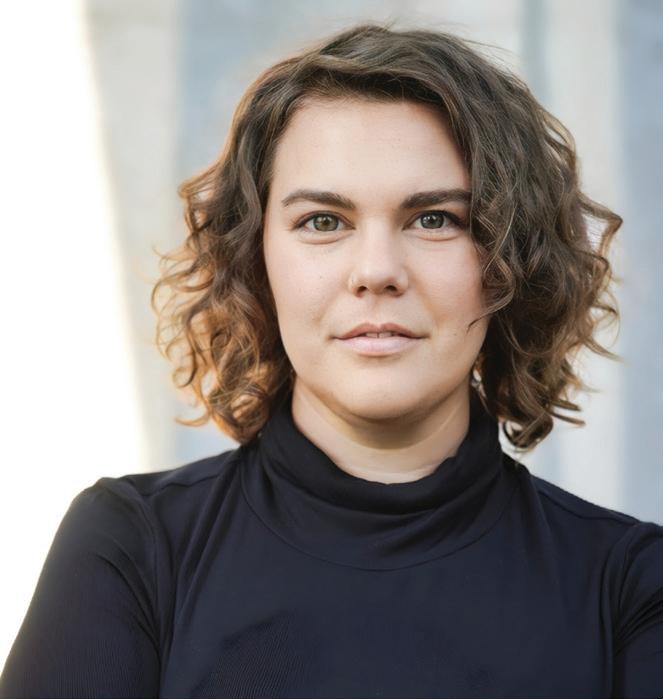
Something that makes other worries insignificant.
The idea of the book came to me at IKEA when I was very pregnant, shopping for a crib, okay? And the building started to shake, because it does when the trucks go by, and I thought it was an earthquake, because I was totally out of my mind with anxiety about the earthquake.
There are parts of this book that talk about Portland’s ongoing problems with unreinforced masonry (URM) buildings. What came first? Did you write the book because of URM or find out about URM while writing the book?
My anxiety came first. And then the book came from the anxiety. When I read the New Yorker article, in 2015, I wasn’t anxious. Amazingly, I was not anxious. And then I got pregnant. And I felt IKEA shake when some trucks drove past, and I became really, really obsessed with the earthquake. Buying an inflatable boat obsessed.
Did you buy a boat?
We moved to a house that is (maybe) going to withstand the earthquake. So, anxiety first, then book, but as soon as I started writing the book, I knew that I had to have an elementary school in it. It’s funny, when I was pregnant, I don’t know if I associated

myself with one day having an elementary school age kid. And now that the book is coming out, I have one. I see my friends really grappling with this because their kids are going to these schools. Basically, any friend whose kid goes to Portland Public Schools, I’m like: “Don’t read my book.” Or if you’re going to read it, don’t read these pages.
I would call that section the book’s climax. However, while so much of Tilt is hyper-accurate, the school you portray is fictional. That was the one detail in the book that I changed. I ended up setting that scene at Revolution Hall because it’s not a school, but it used to be one. Every street in the book is a street I’ve walked down. I rode a bike while nine months pregnant to make sure it would be plausible. But I didn’t want to set the
school scene at an existing school because I felt it would be fear mongering. I didn’t write this to scare parents. My goal, which I hope I achieved, is a fiction book that feels nonfiction. Everything about the earthquake was as accurate as I could make it.
Are you an earthquake prepper?
Yes, I am. But I’m embarrassed to say that I’m like, that person who buys the flashlight, but doesn’t have batteries, buys the huge water canisters, and doesn’t put the water in it. You know, that kind of thing?
Well, I could probably just fill my canisters up from the broken fire hydrant when it happens. Is that what you’re banking on? This book has given me so much—and writing about climate change, being an environmental journalist, has given me so much compassion for our inability to prepare.
Tilt really captures that haunting feeling where someone is just gone. The uncomfortable reality is that if/when the big earthquake hits, a bunch of people will just be gone and we may never know what happened to them. We’re seeing that in Gaza right now; on such a massive scale. And you’re confronted with not knowing, and you have to decide how hard you’re gonna search. It’s been interesting to talk about this book in other cities, because to them an earthquake is a plot device. But it’s like, no. This is a real thing. It’s not a joke.
By the end there’s a strong shift in Annie’s perspective. And the reader has been there with her, so they may feel it too. Letting go of one thing to get a better hold on something more important.
The book started out as a way to come to terms with the fact that I was pregnant, feeling like: “I’m never gonna be the hot young writer. I’m never gonna be a 35-under-35 luminary.” And yet, in writing the book, I have sort of achieved my biggest dream.
Right, just before I came to this interview, I saw that Tilt is on a list of recommended books in the New York Times. It’s been really surreal. NPR called it “exciting fiction.” It’s really cool, and I’m so hopeful that—well, when I started writing this, my biggest dream for this book was that it will mobilize people around Portland schools. I know I sound like a broken record, but it really is the passion of my life.
Tilt is available Mon March 31. Emma Pattee appears in conversation with Margaret Malone at Powell’s City of Books, 1001 W Burnside, Mon March 31, 7 pm, FREE. ■



A new collection from the author of
blurs the lines between trans and cis.
BY BLAIR STENVICK
Stag Dance: A Novel & Stories opens with a note from author Torrey Peters. Still on the heels of her 2021 hit novel Detransition, Baby, Peters shares that she was motivated to keep digging into trans identity this time, posing an underlying question connecting the four stories in her new book: “What does it even mean to be trans?”
It’s quite a question to be asking at this moment in time, as fascist gender policing reaches a boiling point. Those in power are interested in defining transness only insofar that they think they can separate and eradicate it. Well-meaning allies seek to define it through the lens of oppression, lack, and cookie-cutter narratives; even trans folks ourselves can get caught up in gatekeeping traps, seduced by the notion that if we can only find the right words, the right timeline, the right way to be trans, then existential threats will vanish.
The trans characters in Stag Dance didn’t fall out of a coconut tree; they all live under the stifling weight of gender norms. But rather than focusing on the macro, Peters zooms into their interiorities, desires and close relationships, lighting up the pages with specificity, sucker-punch revelations, and some good old-fashioned romantic suspense.
In the titular novel at the heart of the book, a seemingly all-male camp of grizzly lumberjacks plan a dance. To liven things up, lumberjacks have the option to pin a brown cloth triangle onto the crotch of their pants—a makeshift “bush”—and attend as “women” for courting and dancing with. The opportunity stirs something inside Babe, the biggest and ugliest guy in the group, who is the first to claim a bush for himself. He tries to play it for laughs at first, but that changes as he gets to know Lisen, a more delicate and effeminate lumberjack who flirts and wrestles with the other guys.
Watching Lisen tease the men, Babe feels a difficult-to-name stirring:
“His sauciness disturbed me, or rather, I was disturbed by the unctuous temptation it endangered in me, a queer need like how it feels to forget the perfect word for something, even as you know somewhere in your mind you must have the word, that you don’t lack it at all, only its use.”
Trans people can recognize this feeling; it’s the first time you encounter another trans person and feel a terrified-yet-excited surge of familiarity. This crew of 1800s lumberjacks haven’t heard the word “transgender,” and they certainly don’t have knowledge of gender-affirming care. But none of that matters when Babe
wears his brown cloth and hooks up with the camp boss: “With eyes closed, there existed no difference between the triangle and myself: Distinction collapsed, and it was on me and of me and in me.”
Like “Stag Dance , short story “The Chaser” also takes place in the single-sex environment of a boarding school bedroom, where a teenage boy starts secretly hooking up with his feminine roommate Robbie. In the confines of a dark bedroom, where bodies become shapes and curves, their attraction is undeniable. But when a new semester comes and room assignments change, tenderness with Robbie becomes humiliating and untenable for the protagonist: “What was hot for me before was that he was feminine and available, and I set all the terms.”
That’s just one instance of many in which trans women are betrayed in Stag Dance. To be a trans woman in Peters’ stories is to constantly live on a razor’s edge between cis people’s desire and disgust, which often co-mingle. And it often means betraying other trans people yourself, in the pursuit of mainstream approval.
You can see that dichoto my in today’s conservative me dia: There’s a rabid obsession with all trans people—but especially transfem folks—that so clearly stems from insecurity. They are angry at trans people for alighting their own gender and sexuality anxieties, for exposing the absurdity of the gender binary.

There’s a reason transphobes hate being asked their pronouns, and try to claim “cisgender” is a slur: If you have to work to define your cisness, then that means you are in some way defining your own gender, and then doesn’t that make you a little bit trans, too?
That’s exactly what “Infect Your Friends and Loved Ones,” the collection’s most inventive story, explores so deftly. A small team of trans women in Seattle develop and disperse a highly contagious injection that takes away humans’ ability to produce their own hormones, and the US quickly becomes a civil war-torn freefor-all, where everyone is forced to source their own hormones.
“I was thinking I want to live in a world where everyone has to choose their gender,” one of the culprits says by way of explanation. But interestingly, this does not erase

the distinction between trans and cis: A group of trans women who transitioned well before the infection broke out find each other and develop their own community on an abandoned farm, living under the shared principle of “t4t.” The familiar dating app acronym becomes a philosophy of respecting and looking out for other trans folks above all else.
While they’re ostensibly living in a world where everyone is trans in the physical sense, these trans women still find safety primarily in each other. Old resentments, rivalries, and desperation to appeal to cis people for safety and validation fade away. “All it took was the end of the world t o make that happen,” one trans homesteader observes.
The stories in Stag Dance aren’t about brave, articulate transgender people overcoming oppression and leading the way into a genderless utopia. They are instead about messy, flawed trans people attempting to find survival while achieving a modicum
of authenticity, in a hostile world where cis people’s own gender anxieties—and the violence those anxieties can provoke—lurk around every corner.
In the end, true safety can only be found with each other. That seems a salient lesson to remember as new policies attempt to separate the “QT” from the “LGB”—and even to distinguish the good, quiet trans people who keep to themselves from the ones who insist on playing sports, dressing outside the binary, using restrooms without passing, teaching young people, and other apparently flagrant offenses. Still, it’d be a disservice to present these stories only as political fodder. As Peters notes in her introduction, this collection is about trans people as “just people yearning, crashing, loving, and messing up.” These characters stayed with me, and once you crack open Stag Dance, you’ll want to spend some time with them as well.
Stag Dance hits stands on Tues March 11 ■
BY WM. STEVEN HUMPHREY
In case you haven’t noticed, Portland is a hotbed of comedic talent—one that’s been a springboard for the careers of such nationally recognized stand-ups as Ian Kamel, Shane Torres, Kyle Kinane, Matt Braunger, Ron Funches—the list does not stop. That’s why the Mercury is dedicated to spotlighting some of the best comedy Portland has to offer (as well as up ‘n’ coming newbies you just gotta see) with our annual showcase, The Undisputable Geniuses of Comedy!
Since 2016, the Mercury ’s Geniuses of Comedy has been a celebra-
tion of local talent as well as a surefire night of belly laughs. And this year’s edition of Geniuses promises even more fun, with ten highly curated acts of standup, sketch comedy, and wild stuff you’re not going to see anywhere else. Since this sparkling night of laughs plays for only one night (Thursday, March 20 at Revolution Hall), you should get your tickets quick at merctickets.com because it WILL sell out!
Check out our shit-hot lineup of pants-peeing comedic talent at this year’s UNDISPUTABLE GENIUSES OF COMEDY!

YOUR HOST... ADAM PASI!
Quickly becoming one of the most sought-after and highly regarded comics in the Pacific Northwest, Adam is a former Portland’s Funniest Person winner, was featured on the hit show Portlandia , and has appeared at tons of comedy festivals, including the Bridgetown and Big Sky fests. He’s also one of Portland’s best comedy hype men, and trust us, you’ll fall in love with his intense (yet oh-so-lovable) style.
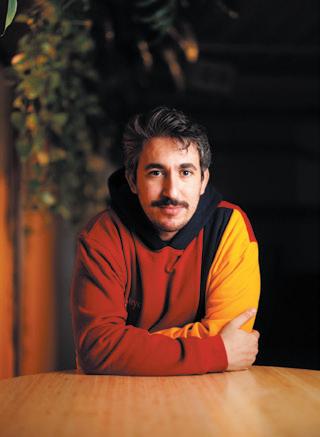
SUPER SPECIAL GUEST… MOHANAD ELSHIEKY!
A blazing former Portland talent, the brilliant Mohanad Elshieky is currently making it big in NYC… but he’s making a special trip back to share his sharp-as-a-whip jokes with YOU. And check out his stats: Mohanad made his national TV debut on Conan and has been featured on Comedy Central as well as Late Night with Stephen Colbert . He’s a writer/consultant for the wildly popular podcast Lovett or Leave It (told you he was smart), and in 2024 was picked for the SF Sketchfest Dozen, a showcase for stand-up comedians on the verge of blowing up big-time! Get ready for his dry, intelligent comedy that will make you laugh at the seemingly unlaughable.
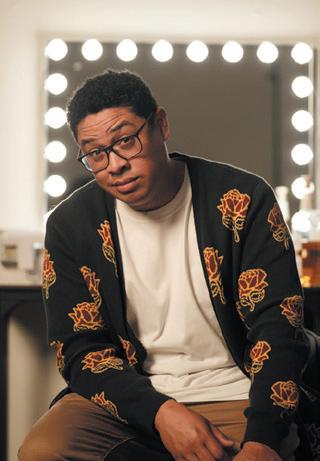
We’re very excited for the return of former Genius of Comedy, Shain Brenden, who seemingly cannot stop getting funnier! Hailing originally from Millington, Tennessee, Shain now calls Portland home, where he became a well-deserved recipient of Portland’s Funniest Person, and was also awarded a featured set on the national pop-up comedy show, Don’t Tell Comedy. When he’s not knocking you on your ass with hilarious jokes, he’s usually at home with his son watching Bluey (so needless to say, he’s very happy to be performing for you at this year’s Geniuses show).

ALLY J WARD
If you aren’t familiar with Ally, she’s one of the hottest Portland up ‘n’ comers in the scene, self-describing as “a dumb baby and good girl.” Along with being an accomplished stand-up, improviser, and story teller, she hosts such queer-driven local shows as Hear You Loud & Queer and the comedy wrestling show Punchlines & Piledrivers. Despite being relatively new to the scene, Ally is already making a big noise, winning a Moth story slam, being chosen for Willamette Week ’s Funniest Five, and was featured as one of the hottest queer comedians of 2024 by Out Magazine . Get to know her and you’ll get to love her!

Most recently crowned as Portland’s Funniest Person 2024, Ben Harkins is well known as both a man of mystery and a public access television legend. His deadpan, quirky/smart style has served him well over the years, scoring him a spot as a 2019 Genius of Comedy and WW ’s Funniest Five as well as appearing in various festivals including Bridgtown and the San Francisco Sketch Fest. He’s also opened for such comedic luminaries as Kyle Kinane, Paulie Shore, Nick Thune, and Louis Katz. Check him out every Thursday as the host of Chill N Fill’s weekly comedy show, or his hilariously weird public access soap opera called Intrigue (now on YouTube)!
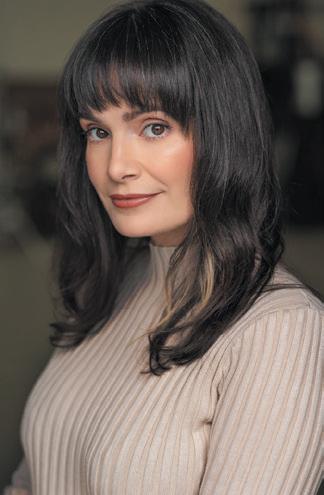
GABBY POCCIA
Gabby may be new to you, but this well-established comedian was knockin’ ‘em dead in San Francisco and beyond before making Portland her home. A vet of the San Francisco Sketchfest and the Savage Henry Comedy Festival, Gabby is ready to get right in your face with her sharp, hilarious, and “unapologetically dirty, shock-andawe” style of comedy. She’s also a member of the comedy folk rock trio, the Satan Sisters—soooooo… prepare to laugh and be only slightly scarred by the experience.

ANDREA MACHACA
If you love self-effacing humor that can spin on a dime and then viciously stab you in the funnybone, then you’re going to flip ass-over-teakettle for comedian Andrea Machaca. A rising star in the Portland comedy scene, Andrea is both a mom and first-generation immigrant whose life experiences form her sharp-witted standup every step of the way. She’s headlined shows across the Northwest, was a Portland’s Funniest Person semi-finalist, and enjoys spending time with her family and giving Republicans sweat-inducing nightmares.

Lee H. Tillman’s comedy may seem laid back, but get ready for lots of very unexpected surprises and left-turns, taking you on a comedy journey you never knew you needed. Hailing from Los Angeles, Lee’s performed at comedy clubs worldwide, knocking them dead at such prestigious comedy fests as the Blue Sky Festival, the Limestone Comedy Festival, and Asheville Comedy Festival. Plus he’s opened for such luminaries as Kyle Kinane, Baron Vaughn, Gabe Rutledge, and Shane Torres, was chosen as one of WW ’s 2025 Funniest Five, and is even the star of his own comedy special “Bad at Math.” If you love impeccable timing, sharp observations, and a sense of humor drier than a cat’s tongue, get ready for Lee Tillman!
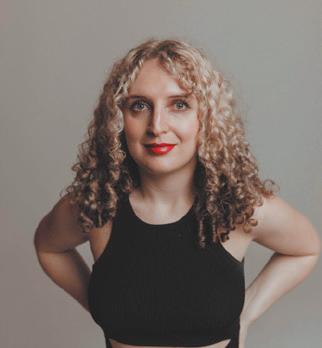
A California native who cut her comedy teeth on the stages of comedy clubs (and dive bars) all over the West Coast, Devi Kirsch has the kind of natural, fun-loving stage presence most comedians would die for. Now a proud Portland transplant, Devi says the most important reason she moved here was because she “was too old to be a stripper anywhere else.” Her sex positive, pointed delivery on such topics as undercover cops and “titty meat” make her a true one-to-watch in the Portland comedy scene—plus she has a pet Pomeranian. (That’s a plus, right?)

Self-described as “the tallest comedy troupe in North America,” The Aces (Shelley McLendon and Michael Fetters) have been absolutely slaying Portland audiences for years with their insanely creative characters, which run the gamut from Wild West lesbians, to helicoptering gorilla parents, to wildly awkward teens on a log flume ride. Their dynamic sketch comedy stylings have been hailed at the Portland Sketch Fest, the Chicago Sketch Comedy Festival, and were so good at the 2016 Mercury Geniuses of Comedy show, we’re inviting them back for another hilarious run! (You’ll thank us later.)
As you can see, this year’s lineup of Portland’s most undisputable geniuses is an undisputable BANGER. So don’t wait—since this show will absolutely sell out, you’ll want to get your tickets quick at merctickets.com for the 2025 edition of the UNDISPUTABLE GENIUSES OF COMEDY, Thursday, March 20, 8 pm, at Revolution Hall! Miss it at your comedic peril! ■
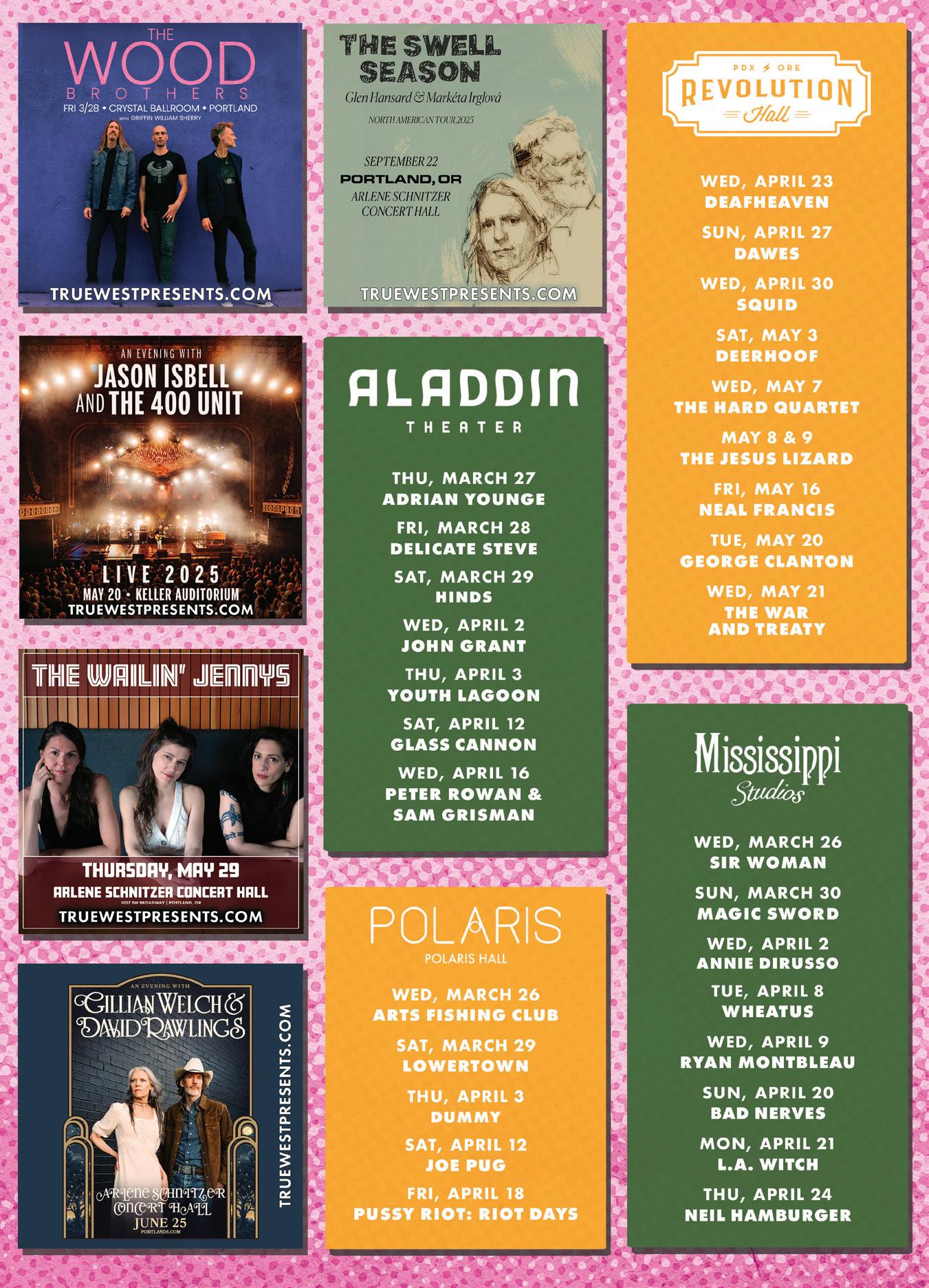
BY JULIANNE BELL, LINDSAY COSTELLO, SHANNON LUBETICH, AUDREY VANN, JANEY WONG
The Antipodes is the latest play penned by Pulitzer Prize-winning playwright Annie Baker, whose A24-distributed directorial debut Janet Planet made waves on the festival circuit in 2023. The synopsis is more than a bit vague—the production “portrays a never-ending brainstorming session for unspecified purposes in an unspecified place”—but hey, there’s a lot to be said for diving into a piece of art with no prior context. The show does promise “no dwarves or elves or trolls,” which raises more questions than it answers. Shaking the Tree Theatre (Through March 22) LINDSAY COSTELLO

Perhaps one of my most “well, duh” opinions is that The Shining is fucking awesome. The story’s spine-chilling environment, replete with lonely halls and snowy mazes, captures the unusual terror
of an isolated place. The Overlook Hotel isn’t just a setting—it’s an entity, a force that whispers and watches, feeding on the weaknesses of its caretakers. Of course I’m seated for the operatic interpretation based on Stephen King’s novel. The production’s score by Pulitzer Prize and Grammy-winning composer Paul Moravec is an extra thrill. Newmark Theatre (March 15–23) LC
You might know comedian, actor, and writer Caleb Hearon from his appearances in films like Jurassic World Dominion I Used to Be Funny and Sweethearts or from one of his many viral comedy videos on social media. In his self-described “most beloved podcast in the world” So True, he preaches the gay gospel to his legions of fans (known affectionately as “Calebrities” and “Calesbians”) and chats with guests like Brittany Broski and Chris Fleming about topics ranging from the ideal chicken wing order to infiltrating the LA lesbian elite. Join him for “an unforgettable night of laughter, surprises, maybe some spirited debate, romance, etc.” Revolution Hall (March 24-25) JULIANNE BELL
Are you normal, or was bonding time with your sibling watching episodes of Alton Brown’s show Good Eats together? His aversion to “unitaskers” and use of yeast puppets belching CO2 to explain bread-making live rent-free in my head. In the promo video for this “farewell tour” of his food-filled variety show, people in hazmat suits wheel a model

Six is unlike any musical I’ve seen before; it’s more like a high-energy rock concert where it almost feels wrong to stay seated the whole time. Henry VIII’s six wives tell their stories and battle it out over who’s the best with bops, ballads, raps, and impressive costumes and choreography. Though we know how their tales end, this engaging adaptation keeps you on the edge of your seat to hear how they met their fates, whether ‘divorced, beheaded, died, divorced, beheaded, [or] survived.’ Keller Auditorium (Apr 29–May 4) SL
of a cow out of a smoke-filled warehouse as Brown promises comedy, music, science, and “an epic yet potentially dangerous culinary demonstration.”
Arlene Schnitzer Concert Hall (Fri March 28) SHANNON LUBETICH

Comedian, rom-com lead, and sometimes FoodTuber Jimmy O. Yang is back on his bullshit, AKA a new comedy tour the 5’ 6” Hong Kong-hailing stand-up has ironically titled Big & Tall. In 2024, Yang starred in the Hulu action-comedy series Interior Chinatown alongside Ronny Chieng and showed up to his own look-alike contest, so his latest anecdotes should have you clutching your sides. I hope he brings his dad—a retired financial advisor who hilariously is signed to the same talent agency as him—onstage for some wholesome bits.
Arlene Schnitzer Concert Hall (Fri Apr 18) JANEY
WONG
Although Showtime tragically canceled her pinkhued, confrontation-as-comedy show in 2023 after a mere two seasons, Ziwe Fumudoh’s buttonpressing 2022 interview with Chet Hanks is still the stuff of legend. The snazzy satirist and queen of discomfort has a gift for finding “iconic guests” (Fran Lebowitz, Gloria Steinem, Stacey Abrams) and bringing out cringe-inducing behavior in privileged people (Andrew Yang, Hannibal Buress, Adam Pally, Caroline Calloway). She tends to do it all in Cher Horowitz-chic outfits What’s not to love (or be mildly nervous about)? She’ll drop by Portland to remind us that Earth is in its flop era Aladdin Theater (Sat Apr 26) LC

In 2015, Scarlett Johansson was controversially cast as cyborg heroine Motoko Kusanagi for the live action adaptation of popular Japanese manga series Ghost in the Shell sparking much debate. Examining the concepts of whitewashing, identity, and what’s possible as an artist, Asian American actor and comedian Chris Grace plays Johansson
in this one-man show, which won the Hollywood Encore Producer’s Award at the Hollywood Fringe Festival in 2023. Using an arsenal of wigs, stage combat, and gallows humor, Grace’s exploration of casting and diversity in Hollywood is “mind and character bending.” (The Guardian). Portland Center Stage (May 11–June 22) SL
Preacher Lawson: Live Special Taping
Aladdin Theater (Sat March 22)
Nish Kumar - Nish, Don’t Kill My Vibe Mississippi Studios (Mon March 24)
Hedda
Newmark Theatre (March 28–29)
How Did This Get Made?—Live!
Arlene Schnitzer Concert Hall (Wed Apr 2)
Life of Pi
Keller Auditorium (Apr 8–13)
Pussy Riot: Riot Days
Polaris Hall (Fri Apr 18)
Trisha Paytas - The Eras of Trish Tour
Arlene Schnitzer Concert Hall (Fri May 2)

Bearing an appropriately absurd title, performance artist, poet, musician, and educator Karen Finley’s suite of poems COVID Vortex Anxiety Opera Kitty Kaleidoscope Disco brilliantly captures the chaos and surrealism of living through the pandemic: a blend of Zoom dance parties, obsessive handwashing, strange rituals, coping mechanisms, grief, social upheaval, and political revolution. Finley originally performed this collection as a live show at theaters in New York, garnering favorable comparisons to Beat legends like Allen Ginsberg and Gregory Corso from the Village Voice and earning a New York Times Critic’s Pick. Ultimately, she identifies art, language, compassion, and humor as the keys to survival during our tumultuous times—a welcome reminder of our humanity that might serve us well as we navigate the next four years. Powell’s City of Books (Wed March 26) JB
Comic provocateur Robert Crumb is, first and foremost, still kickin’, which is fantastic news for us. The underground comic book pioneer will visit Revolution Hall for a chat with Dan Nadel, a curator




Find our cartoons on Instagram, Twitter and Facebook
Miranda July, a strong candidate for the coolest person ever born in Vermont, is a filmmaker to be reckoned with—if you’re into her vision at all, you’ve probably seen Kajillionaire, Me You and Everyone We Know, and/or The Future already. She’s also a writer. The heroine at the center of July’s 2024 novel All Fours is a 45-year-old artist staring down the rest of her life. I am not 45, but I am already anticipating the barrage of thoughts on monogamy, domesticity, and bodily autonomy that one might navigate at that age. July tackled it all with her thrilling, freaky, and subtly comical voice. It makes sense, then, that she’d be the one to curate a film series on “Time/Space/Reality/Memory/Truth Being In Question.” On April 6 and 27, Tomorrow Theater will screen her picks, including Random Harvest, The Truman Show, The Heiress, and Somewhere In Time. PAM CUT’s Tomorrow Theater (Apr 6 & 27) LC
and writer specializing in comics and art whose 2019 biography Crumb: A Cartoonist’s Life tracks “Crumb’s highly dysfunctional early family life, the history of comics and graphic satire, 20th-century popular music, the birth of underground comic books in 1960s San Francisco with Crumb’s Zap Comix, [and] the economic challenges and dissolution of the hippie dream.” If you have even a passing interest in the ‘60s-era “comix” movement, I recommend this talk. After all, what started with Crumb’s wacky humor led to a lasting cultural impression—comix reframed popular thinking on the war, racial justice, gender expression, and more. Revolution Hall (Mon Apr 21) LC
Did you know that TEDxPortland is recognized as the largest independently organized TEDx event in North America? And it’s officially a teenager! With the theme “Continuum” for its 13th year, expect reflections on time, “the silent artist painting the canvas of our lives” that recalls memories and reaches into the future. Ten world-class speakers will welcome you to their TED Talks at the Keller Auditorium—I’m excited for insights from legendary soccer player and recently retired Portland Thorns forward Christine Sinclair; photojournalist and Eight Seconds Juneteenth Rodeo founder Ivan McClellan; Brian McLean, LAIKA’s director of rapid prototype; and whimsical local illustrator Mike Bennett. Keller Auditorium (Sat Apr 26) JW
If you’ve visited a bookstore anytime in recent memory, you’ve likely spied a copy of Rebecca Solnit’s smash-hit essay collection Men Explain

Things to Me—or perhaps Recollections of My Non-Existence, or Hope in the Dark, or The Mother of All Questions. The longtime writer and activist is the closest thing to a literary household name we’ve got right now, and in No Straight Road Takes You There, she delves into themes of climate change, feminism, democracy, hope, and the abuse of power. If you’re like “Whew, okay, I don’t know if I need more of that at the moment, I’d rather read Ariana Madix’s cocktail book,” first of all: I get it. But consider this: Solnit has a way of making even the heaviest topics feel expansive rather than crushing. It might be just what you need to survive the next few years. Beloved local author Lidia Yuknavitch, who penned Reading the Waves and The Chronology of Water, will join her in conversation. Revolution Hall (Tues May 13) LC
Smallpresspalooza #14
Powell’s City of Books (Sun Marchj16)
The Portland GrandSLAM
Aladdin Theater (Tues March 25)
Steve Inskeep: 2025 Hatfield Lecture
Arlene Schnitzer Concert Hall (Tues Apr 8)
Oregon Book Awards
Portland Center Stage (Mon Apr 28)
Professor Brian Cox: Horizons Newmark Theatre (Tues Apr 29)
Viet Thanh Nguyen in Conversation with Lois Leveen
Powell’s City of Books (Tues May 6)
If you’re more partial to movies than basketball, this bracket pitting millennial films against each other is for you. The competition has already started, but you’ve still got time to catch several showings, including both finalists in the “Lit Adaptation Bracket” on March 22—the Shakespeare-inspired 10 Things I Hate About You and Romeo + Juliet Don’t miss Alfonso Cuarón’s gorgeous 2001 film Y Tu Mamá También on March 23, which I didn’t watch until my late 20s but fully believe everyone should see. Legally Blonde caps off the “Teen Dream Bracket” showings on March 21 with bingo hosted by drag queen Violet Hex. I’m hoping for a group “bend and snap.” PAM CUT’s Tomorrow Theater (Through March 28) SL
Your new favorite film festival has two goals: to screen significant international films and selections by filmmakers from Northwest North America. The brand-new festival is one to keep your eye on—Portland Panorama’s team draws from “extensive experience in organizing festivals such as the former Portland International Film Festival and Northwest Filmmakers’ Festival.” The inaugural lineup includes screenings of the gorgeous beekeeping documentary Amrita the Oscar-winning Dutch short I’m Not a Robot the supernatural dark comedy Fishmonger, and an episode of Portland’s own Bourdain-esque docuseries Food Foray Various locations (Apr 10–20) LC
The Portland EcoFilm Festival
Hollywood Theatre (March 6–June 21)
Butterfly in the Sky
5th Avenue Cinema (March 14–16)
Found Footage Festival: 20th Anniversary Show
Hollywood Theatre (March 21–22)
Animation April
Clinton Street Theater (Apr 5–29)
New Indigenous Short Films (“Earth Day!”)
Hollywood Theatre (Tues Apr 22)
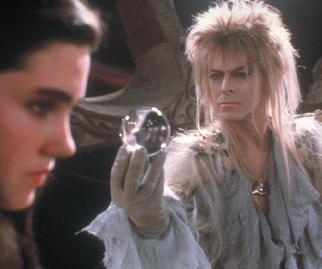
Jim Henson’s Labyrinth isn’t a hard sell for most people. The 1986 cult classic has everything: David Bowie, puppets, delightfully dated hairdos,

As a Breeders fangirl who has obsessively followed the Deal sisters’ various other projects (Pixies, the Amps, the Kelley Deal 6000, etc), I was very intrigued to hear Kim Deal’s debut solo album. Nobody Loves You More arrives nearly four decades into her prolific career, but Deal sounds as timeless and effortlessly cool as ever. At first listen, I was caught off guard by the orchestral flourishes and big band-style horns that graze the opening tracks “Nobody Loves You More” and “Coast.” But contrasted with moodier downbeat songs (“Bats In The Afternoon Sky” and “Are You Mine?”) and gritty experimental tunes (“Crystal Breath” and “Big Ben Beat”), the album forms a cohesively incohesive collection of tracks that would be perfect for dissociating around happy people—a common thread that runs through Deal’s discography. She will support the album after an opening set from singer-songwriter Morgan Nagler, who has co-written material for Phoebe Bridgers, Haim, and the Breeders. Revolution Hall (Sun March 23) AUDREY VANN
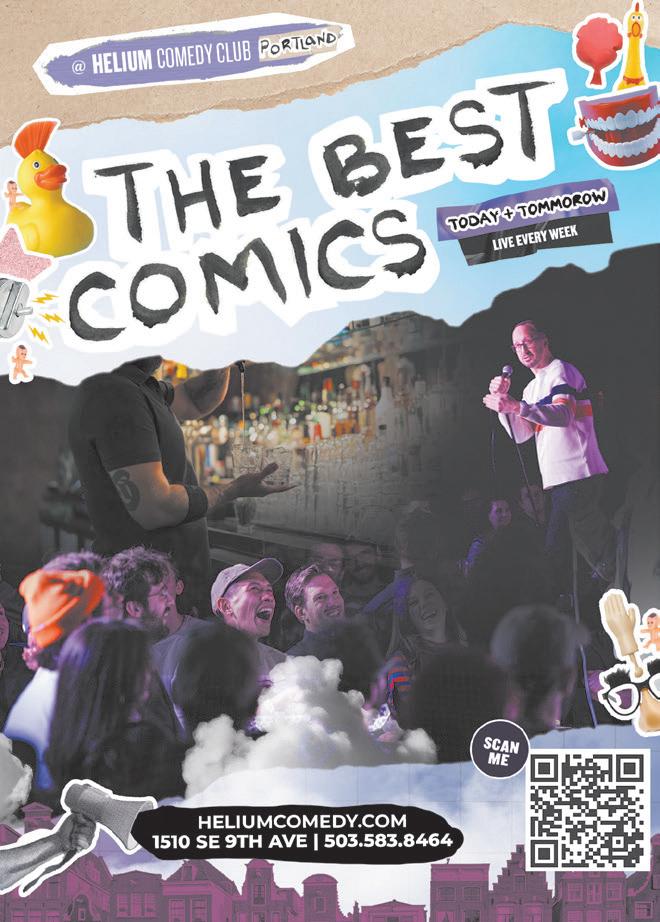

a stolen baby plot—what more could you ask for? And even if you’ve seen this film a bajillion times, I bet you’ve never seen it with a live score. At this screening, an orchestra and rock band will perform the soundtrack in sync with the film, complementing Bowie’s original vocals (because he is the only Goblin King). Revolution Hall (Thurs March 27) AV

World-renowned cellist Yo-Yo Ma formed the musical collective Silkroad Ensemble in 2000 as a project under the broader Silkroad arts organization. Over its lifespan, the ensemble has had as many as 59 musicians, composers, artists, and storytellers at a time with the joint goal of encouraging cross-cultural collaboration. Ma passed the title of artistic director to Rhiannon Giddens back in 2020, but the mission of the ensemble remains the same. Championing women and nonbinary performers, their newest program, Uplifted Voices, spotlights under-recognized voices from across the globe to change our perspective of the history and migration of music. The ensemble will perform a global tapestry of folk and ancestral pieces alongside the Oregon Symphony with special guest Indigenous activist, storyteller, and musician Pura Fé. Arlene Schnitzer Concert Hall (Tues Apr 1) AV

Kraftwerk’s 1974 album Autobahn is a potent antidepressant. I can always depend on the opening titular track to lift my spirits and get me out of a rut. The song’s slow-building electronics make me feel like a glossy ‘70s BMW that’s powering on to follow the German lyrics “Wir fahr’n, fahr’n, fahr’n, auf der Autobahn” (which loosely translates to “We are driving on the highway.”) Lead singer and founding member Ralf Hütter will get back on the “autobahn” to celebrate the 50th anniversary of the band’s first US tour. This special multimedia concert will bring together Kraftwerk’s pioneering electronic tunes with trippy futuristic visuals and performance art. Keller Auditorium (Sun Apr 6) AV
The word “ethereal” tends to be overused when describing music. That being said, Ichiko Aoba’s music is actually ethereal. The Japanese singer-songwriter finds a sweet spot between folk, jazz, and classical music, employing swirling strings, ocean waves, windchimes, and delicate vocals to tell whimsical, and often fictional stories. She will support her new album Luminescent Creatures, which serves as a sequel to her critically acclaimed 2020 album Windswept Adan. Revolution Hall (Sun Apr 20) AV

Yukimi Nagano has fronted the Grammy-nominated Swedish electronic group Little Dragon for nearly three decades, but she steps into her own on the solo project For You coming out March 28. The songs feel more intimate, with a feminine energy that emanates strength as she sings, “Nothing’s gonna break me down / Nothing’s gonna shake / No one’s gonna break me.” Without the confines
of a band, she has the freedom to take risks and explore new approaches. The singles that have been released so far are emotional, jazzy, soul-filled, and just gorgeous. Wonder Ballroom (Tues Apr 29) SL
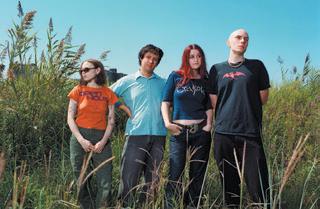
School friends Etta Friedman and Allegra Weingarten started the band Momma in 2015 outside of Los Angeles and have since moved to Brooklyn, added a drummer and bassist, and signed with Polyvinyl after the label cold-emailed them. While their early music might’ve been categorized as ruminative and lo-fi, Momma has really tapped into their power as an indie rock band with the recent singles from their upcoming album Welcome to My Blue Sky. The songs are already stuck in my head, and I take every opportunity to scream-sing them in my car. Indianapolis band Wishy opens the show with pop-punk-tinged grooves. Aladdin Theater (Mon May 12) SL
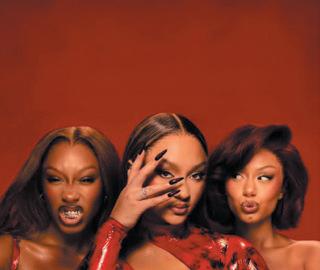
When I first heard the London-formed trio FLO’s 2022 debut song “Cardboard Box”—a banger of a breakup anthem in the tradition of Beyoncé’s “Irreplaceable”—it was love at first listen. The British girl group hearkens back to the best of ‘90s and earlyaughts R&B and pop, bringing to mind iconic artists like TLC, Aaliyah, and Destiny’s Child with their mellifluous harmonies and irresistible hooks. They did it again with their 2024 single “Walk Like This,” a cheeky postcoital bop dedicated to the “certified lover girl in us all.” Their debut album Access All Areas features guest vocals from stars like Cynthia Erivo and GloRilla, with appearances from Chlöe, Halle, Kehlani, Bree Runway, and Dixson on the “Unlocked” deluxe edition. Roseland Theater (Thurs May 15) JB

In Dinh Q. Lê’s 2023 solo show at Elizabeth Leach, Cambodia Reamker , the artist navigated themes of displacement and war through a series of photographic weavings. The works depicted Reamker , the national epic of Cambodia, and portraits of incarcerated people in Tuol Sleng, a notorious Khmer Rouge prison. Lê, whose family was forced to flee the Khmer Rouge in 1978, created “alternative narratives” that blended references to the country’s rich cultural traditions and tragic recent history. Over his career, though, Lê drew from a wide variety of inspirations and materials, from Vietnamese mat weaving techniques to western product logos, Hollywood film stills, and Buddhist and Communist symbols. The artist passed last year. This career survey brings together three decades of Lê’s experimental, meditative works, including photographs, photo-weavings, and sculptures made between 1995-2023. Elizabeth Leach Gallery (Through Apr 26) LC
Musician Sasami Ashworth says that she wanted to “go all out” with her third album, Blood on the Silver Screen: “I wanted to, in my tenderness and emotionality, have the bravery to undertake something as epic as making a pop record about love.” Mission accomplished: The dramatic record, made in collaboration with producers Jenn Decilveo and Rostam, evokes a larger-than-life presence, citing influences ranging from Britney Spears’ Femme Fatale and Lady Gaga’s Born This Way to Kelly Clarkson, Katy Perry, Sia, Prince, Bruce Springsteen, and Japanese city pop. Tracks like the sassy “Slugger,” the incendiary, shiver-inducing “Honeycrash,” and the synthy “In Love with a Memory” (featuring Gen Z sensation Clairo) readily display Sasami’s impressive range. Wonder Ballroom (Tues May 20) JB
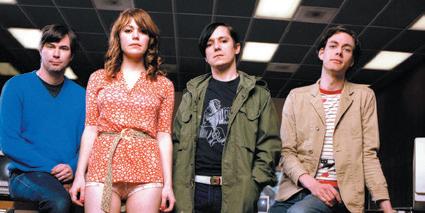
When the 2025 lineup for Pasadena music festival Just Like Heaven dropped in late January with Rilo Kiley on the bill, the internet began buzzing Did the reunion indicate a full tour for the indie legends? Fans didn’t have to wait long: A week later, the Jenny Lewis-fronted four-piece announced their first tour since 2008. The Sometimes When You’re On You’re Really F**cking On Tour is named after a lyric plucked from “A Better Son/Daughter” off the band’s breakthrough sophomore album The Execution of All Things, which will get a reissue this spring from Saddle Creek Records. “The stakes are only to have a good time, to revel in this nostalgia,” says bassist Pierre de Reeder. I can barely contain my excitement for this one; I’m expecting loud-ashell singalongs, tears, the works. Grand Lodge (Fri May 23) JW
Jazz Is Dead: Adrian Younge Aladdin Theater (Thurs March 27)
Pink Martini’s Special Celebratory 30th-Anniversary Hometown Concert Revolution Hall (Apr 14–15)
Calexico
Patricia Reser Center for the Arts (Fri May 2)
Wet with Julie Byrne Aladdin Theater (Sat May 10)
The Weather Station: Humanhood Tour
Mississippi Studios (May 12–13)
Dean Wareham
Mississippi Studios (Tues May 20)
Jack White: No Name Tour
Edgefield (Sat May 24)
Outlaw Music Festival: Willie Nelson & Family, Bob Dylan, and More
Cascades Amphitheater (Sat May 24)
Leon Bridges: The Leon Tour
Edgefield (Wed May 28)
Titled after a linguistic term for a “loanword” partially adapted from a classical language into a modern one, Bogotá-born, Oregon-based artist Pete Hoffecker Mejía’s Semi-Learned Borrowings incorporates discarded materials—think commercial packaging, wood scraps, and plastic—and pairs them with precise constructions of welded steel and laser-cut Plexiglass. The resulting works reference Latin American abstract art history while exploring

Celebrated Nostrana chef/owner and six-time James Beard Award finalist Cathy Whims joins forces with a lineup of other Oregon chefs and purveyors for this annual event inspired by cozy “cold-weather gatherings and the spirit of culinary education, wrapped in Italian tradition.” “Maialata” refers to an age-old tradition rooted in Northern Italy, where rural communities come together to prepare a whole pig for preservation and then savor a celebratory feast afterward. This eight-hour-long event will feature a lavish spread, an abundant flow of wine, and hands-on cooking lessons, plus a whole animal butchery demonstration led by Andrea “Guido” Falaschi, a fourth-generation Italian butcher from Macelleria Falaschi in San Miniato. Cana’s Feast Winery (Sat March 22) JB
curious questions of representation and hierarchy. Well Well (Through March 30) LC
Printmaker-ceramicist Rebecca Boraz’s debut exhibition feels pensive and quiet, with a muted color palette and abstracted figures in repose. The show’s title, Holding Space finds two meanings in the context of Boraz’s work—both “being fully present with another, offering a non-judgmental, safe space where someone can feel seen,” and also articulating a “construction of forms using shape, line, and contrast, which occupy and define space.” The results are moody and layered, inviting contemplation. Froelick Gallery (Through Apr 12) LC
Extinction Rebellion Portland, Sunnyside Environmental School, and do-good Gaia lovers Making Earth Cool will bring some environmental joie de vivre to the city on April 26. Their Earth Day celebration “serves as a poignant reminder that we are mere specks within the grandeur of the greatest masterpiece ever created.” Couldn’t have said it better myself! Although we are but small specks on our majestic planet, the event gives us all something
Earthen Elegance: The Ceramic Art of Bizen
Portland Japanese Garden (Through June 9)
Let ‘Er Rip 811 Stark (Through June 30)
Anya Roberts-Toney Nationale (Apr–May)

London-based chef Tim Anderson’s gilded tome Vegan JapanEasy provides a playful primer on plant-based Japanese cooking, featuring dishes like baked sweet potatoes with truffled ponzu, cauliflower katsu curry, French onion ramen, and soy sauce butterscotch brownies. There’s even a guide to creating your own colorful bento boxes by mixing and matching bites like squash braised in dashi with mirin and ginger, citruspickled radishes, and kinpira-style veggies. At this workshop from cookbook store Vivienne Culinary Books, students will cook several courses from the book together, then enjoy a communal Japanese meal. Vivienne Culinary Books (Sat Apr 5) JB
This April, brewers and beer lovers congregate at Revolution Hall for the Oregon Beer Awards, which celebrates 10 years of crisp competition. All of the competing beers from breweries statewide are judged in a double-blind process, ensuring the only best of the best are recognized. Attendees will no doubt discover dozens of superlative brews to bookmark on their Untappd “to drink” list with specific categories such as “experimental and historical beers,” “fruited mixed culture beers,” and “sessionable hoppy beers.” Revolution Hall (Thurs Apr 10) JW
to live for: gigantic puppets, live music, crafts, and an “Earth Ceremony.” You’re invited to dress up as your fave flora or fauna for a costumed parade, too. (Sat Apr 26) LC
The Portland Art Museum has conserved Monet’s treasured 1914–15 painting Waterlilies, returning the painting to the form Monet originally intended— sans varnish. The restoration, which “resulted in new color harmonies and brightness,” will be presented in Monet’s Floating Worlds at Giverny: Portland’s Waterlilies Resurfaces, which will also include prints from the museum’s Asian art collection, photographs of Giverny and Portland’s Japanese gardens, and works by Henri Rivière, Édouard Vuillard, Jules Chéret, and others. It’s perhaps the most romantic way to spend a spring afternoon. Portland Art Museum (Through Aug 10) LC
Her Formation ARTspace (Through Apr 11)
Just Playin’ Around Jordan Schnitzer Museum of Art (Through Apr 26)

At the 10th edition of this annual all-ages festival, you’re invited to gaze upon the scenic waterfront environs of Hood River and take advantage of 60 selected ciders, on tap from nearly 30 Oregon and Washington cideries. Guests under 21 get free admission, making it an ideal family outing, for those who cannot imbibe may still enjoy myriad offerings from local craft and food vendors. Hood River Event Site (Sat May 3) JB
(March 29–30)



Opening Reception March 22 from 12:00 to 4:00 PM


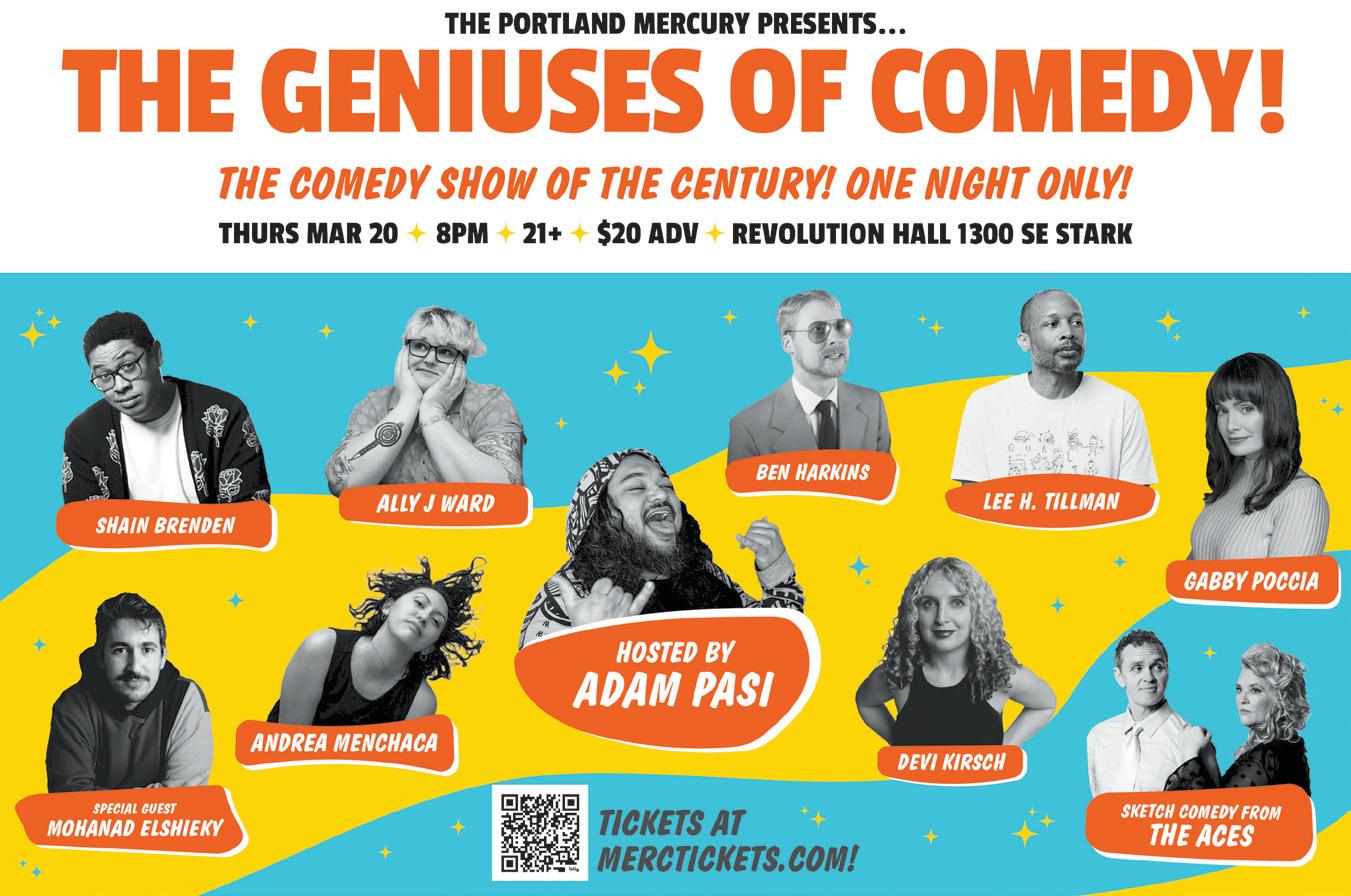
BY DAN SAVAGE
I am a straight married man. My wife and I have a 4-year-old and a 3-monthold. We’ve just started having intercourse again. For Valentine’s Day, we spent the night in a B&B while grandma watched the kids. We had edibles, drank sparkling wine, and then fucked. It was amazing. After we came and while we were still stoned and drunk, my wife mentioned she was open to inviting others into our sex life. I asked about getting a professional sex worker. She said no. But maybe if we were in a bar (we’re never in bars) and met someone (a unicorn), she might be into it. Anal came up. She’s always said she’s up for trying anything once. I have a desire to experiment with anal. (Not just me entering her, but her pegging me as well.) I asked if she would use the vibrator we brought on me, just to experiment. She said she was too high to do anything. I felt let down. I feel she unknowingly teased me with fantasies I have, not knowing I actually have them. We have a good sex life, and I’m willing to write off the fantasies we discussed while high and drunk. It’s the teasing that drove me crazy.

and share fantasies, even at the risk of frustrating the Team Realize spouse.
Having And Realizing Desires P.S. I’m in no hurry. We just had a baby, and I don’t want to pressure my wife right now. My fear is that she may only like the idea of exploring our sexuality together and not the reality of it.
Some people think about, talk about, and masturbate about certain fantasies without ever wanting to realize them. Let’s call them Team Fantasize. Some people think about, etc., certain fantasies and would very much like to realize them. Let’s call them Team Realize. There’s nothing wrong with either team. But when someone on Team Fantasize is married to someone on Team Realize, well, that can be a problem. Knowing your spouse is turned on by fantasies you share but rules out realizing them—or sets impossible conditions for realizing them—can be extremely frustrating. And sometimes a frustrated Team Realize spouse will say something like this to their Team Fantasize mate: “Talking about these fantasies together— this kind of dirty talk—it gets my hopes up about actually doing it. If it’s never going to happen, we have to stop talking about it, because it’s frustrating.”
The problem with that approach? Swingers clubs, BDSM parties, and the strap-on-dildo sections of your finer sex-positive sex-toy stores everywhere are filled with couples who used to be on opposite teams—one from Team Fantasize, the other from Team Realize—but they’re both on Team Realize now. And what got them on the same team? Continuing to discuss
So, if you ever want to have that threesome or experiment with anal, HARD, you need to keep talking with your wife about these fantasies— and you need to tell her your fantasies too! Tell her you’re not pressuring her, of course, but let her know these are things you would actually like to do, and the more you talk about them, the more you want to do them. If she keeps talking with you about them, that’s a sign. Not a sign that she’s a cruel tease, HARD, but a sign that she’s inching closer toward pulling on a Team Realize jersey.
P.S. If your wife doesn’t know you have these fantasies—and is consequently teasing you “unknowingly”—that’s your fault, HARD, not hers.
I wanted to tell you about something that happened to my friend. (Really!) She was going to bang this dude from OkCupid but wasn’t getting a great feeling, so she went to bed and let him crash on the couch. She woke up the next day to find her underwear drawer empty on the floor and all of her underwear wrapped around this dude’s feet. She stealthily removed all the panties from his perv hooves and put her shit away. When the morning actualized itself, they parted amicably with no mention of the underwear slippers.
Men In Alaska
Ask yourself, MIA, which is the likelier scenario:
Scenario One: Perv Hooves stumbled around your friend’s dark apartment in the middle of the night, managed to find her underwear drawer, pulled it out and set it on the floor, made himself a pair of pantie-booties, had himself a wank, and fell back to sleep. All without waking your friend. Then your friend got up in the morning, saw her panties wrapped around his hooves, peeled them off one by one, and returned her panties to their drawer. All without waking Perv Hooves up.
Scenario 2: Your friend got a little pervy with this guy—a thing for feet and/or panties isn’t that pervy—wanted to tell you about this guy’s kink, but was too embarrassed to admit that she’d gone along and possibly got into it.
While Scenario One is entirely plausible—it could’ve unfolded that way—my money is on Scenario Two because I’ve heard so many variations of song over the years: “I met this pervert who did these perverted things in front of me while I was asleep, and I wasn’t in any way involved and I wasn’t harmed. Isn’t that pervert crazy ?” In most cases it only took a little drilling down—a little pointed questioning—to learn that person relaying the story played an active role in the evening’s perversions but edited the story to make themselves look like a passive bystander, not a willing participant.
I’m a 30-year-old straight woman who has been with the same guy (high-school sweetheart!) for the last 13 years. We love each other deeply, best friends, etc. The problem isn’t that the sex isn’t good—he’s very good at making me come. But the sex is vanilla and routine, and I would like us to go beyond that. Nothing extreme, I just want to switch things up a bit. Talking about sex makes my husband REALLY uncomfortable. If I ask him what he’d like me to do to him while we’re having sex, he shuts down. He’ll say, “Everything you do is good,” and leave it there. In the very few conversations we’ve had about this stuff, he’s said that he feels intimidated and doesn’t know what to say. This is incredibly frustrating for me. How do I get him to loosen up and feel more comfortable about talking to me so that we can eventually progress to some new experiences?
Why Husband Is Prudish
Have you told him what you want? If you haven’t—if you’re as vague in your conversations with him as you were in your letter to me—you’re essentially asking your husband to guess at your undisclosed interests or kinks. Your husband is rightly terrified of guessing wrong. He doesn’t know what to do, he doesn’t know what to say, but he’s told you he’s fine with whatever you wanna do. So, stop asking him what he wants to do to you, WHIP, and start doing (or telling him to do) whatever it is you wanna do. Take the initiative! Be the change/switch you want to see in the sack! Lean in! Or bend over! Or whatever!
From your sign-off, WHIP, I’m guessing you’re interested in some type of BDSM play, most likely with you in the sub role. So, lay that kink card on the table… but maybe offer to dominate him first. A lot of subs do some topping, i.e., a little doing unto others as subs would done unto them, and some subs become tops exclusively. Gently topping your husband — baby steps — is a good way to show him what you want since you’re finding it hard to talk about it. P.S. Doing things you haven’t discussed isn’t ideal. So, emphasizing again the importance of taking the tiniest of baby steps here. You wanna give him a small taste of what it is you want, WHIP, not shove the whole roast down his throat. And insist on talking after ■
Email your question for the column to mailbox@savage.love! Or record your question for the Savage Lovecast at savage.love/askdan! Podcasts, columns, and more at Savage.Love


